2018
DECEMBER
Hi Everyone!
Our rain dance worked!! Yay for rain and more to come. As the year rolls to its end, I am getting excited for the IUH annual winter open house. Goodies are getting bottled, packaged and labeled as I sift through the bounty of this years harvest. I am happy to be able to offer honey again this year, as well as a fantastic array of jam, new tile designs, lots of dried fruit from my farm and much much more. I have written below a bit about some of the different products you can look forward to. I am also looking for a few volunteers to help out (details below). It is a fun easy shift and you get a goodie bag from me in thanks.
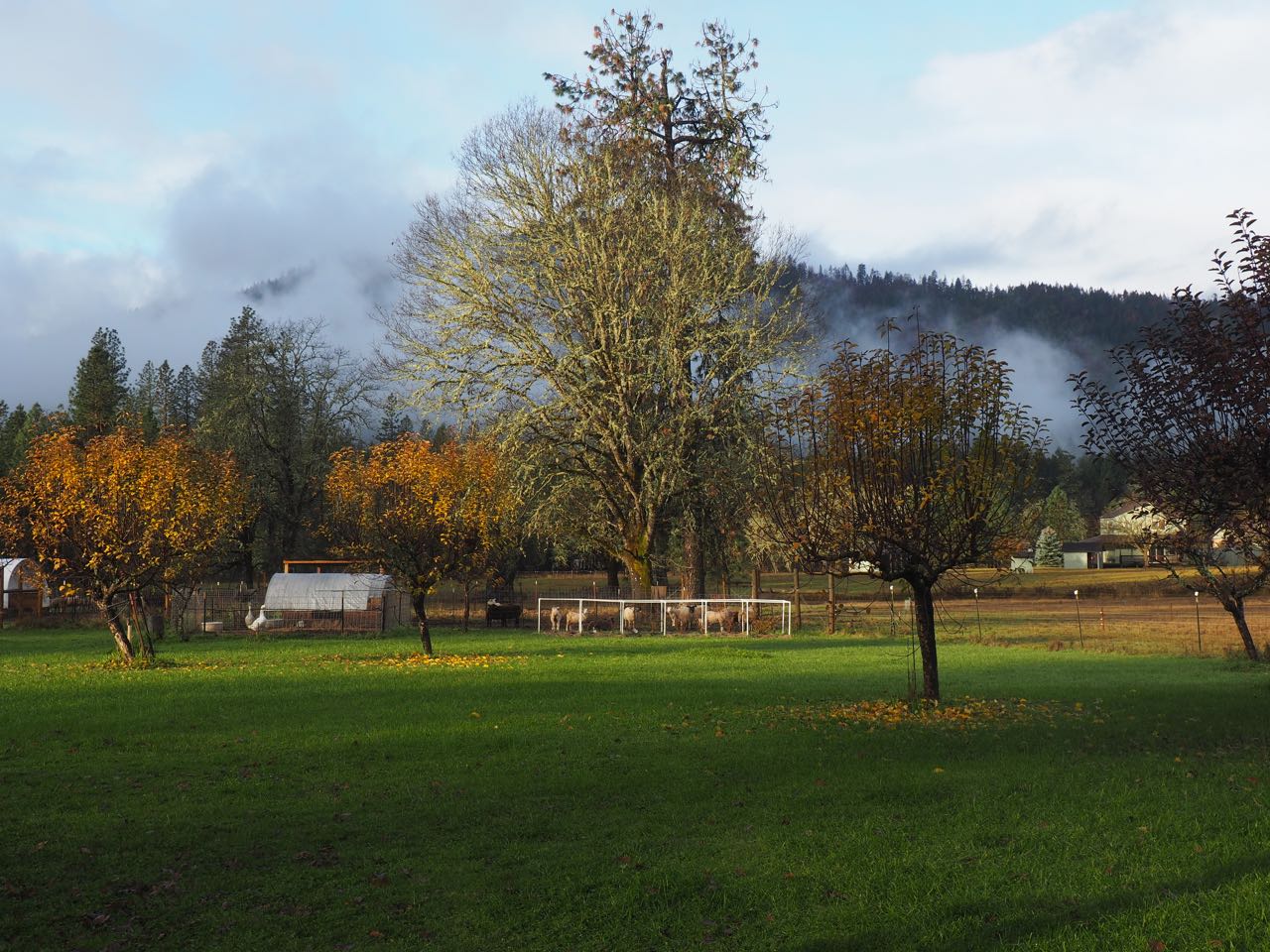
a beautiful winter day
WINTER OPEN HOUSE Tasting, Social & Sale
Saturday & Sunday December 15 & 16 12-4 each day
On top of A Hill at the End of the Road
Buena Vista Wood 3090 Buena Vista Berkeley
So much Jam! Mustard, honey, soap, herbal goodies, cbd on the cheap, tinctures, cordials, shrubs, vinegar pickles, salsa, dried fruits, fancy apple sauce salve, hand spun yarn, art tiles, pottery, seeds, pesto, caramels and so much more. Small-batch, hand-crafted goodies at way below market price. These make truly unique gifts as you cannot get these items anywhere else. Come taste some homemade products, stock up on your stocking stuffers, Secret Santas and private stash.
Mini Talks 1pm & 3pm each day
5-10 minute speed lessons plus Q & A in the kitchen.
Saturday: 1pm Soil, 3pm Fermentation
Sunday: 1pm Bees 3pm Raising Animals in the City
PLUS! FREE Breema treatments will be offered throughout the day.Breema is a form of bodywork that has been described as a cross between partner yoga and Thai massage. The techniques may be utilized in either a practitioner-recipient mode or solo as “Self-Breema.” The practice is intended to bring body and mind together, and no strong exertions or muscular contortions are involved.
All in a fabulous secret Berkeley location
Just 7 minutes by car from the gourmet ghetto, Buena Vista Wood is a rare 3 acre parcel that is a slice of country living right in the heart of Berkeley. Built in 1936 this rare brick home is filled with exquisite and well-kept redwood detailing inside and boasts amazing expansive views of the Bay. The home has always been inhabited by artists recently came into the hands of the Johnson Family who have plans to develop the grounds into a productive food forest. It is worth coming to the open house, just to see this special secret spot. I recently learned that one of the residents through history was David Wood, who started the UC Berkeley Dance program. I went to grade school with his kids and trained with him when I was at Berkeley High in the 70s. Small world! Other artists who resided here included a mid-century UC Berkeley Theatre Dept. head and Michael Cronan of the “Pacific Wave” graphic design movement.
Getting There
Driving: At the top of Cedar Street, turn left onto La Loma and then take the second right onto Buena Vista Way, which curves around as it meanders to the top of the hill. The house is at the very end of Buena Vista. There is parking for about 10 in the cul-de-sac at the end of the road—please park close so we can squeeze people in. If spaces there are full please park on Buena Vista Way about 150 feet from the start of the driveway as the two closest neighbors reserve the drive for their parking.
Public Transit/Walking: The closest bus route is the #65 from downtown Berkeley which will drop you off at Euclid and Buena Vista, leaving with a 15-30 minute walk up Buena Vista-(depending on how fit you are).
Biking: Totally possible, though Buena Vista is rather steep.
You could also consider taking an Uber or Lyft up the hill and we will help you find a carpool back down with another guest.

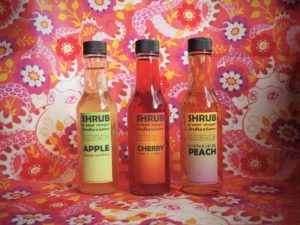
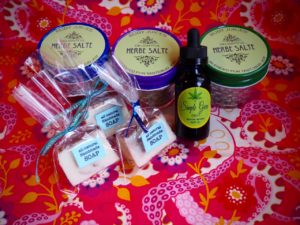
ABOUT SOME OF MY GOODIES
Jam Jam and more Jam. I’ve been jamming for years and have a small but dedicated following of fans, wanna join the fan club? I make my jams using about an eighth of the sugar used in commercial jams resulting in a delightful fruit forward product where you can literally taste the sun. The jams are more perishable than regular jams, but because of the reduced sugar can also be easily consumed in a few days. My jams are suitable for being added to yogurt, musli, oatmeal or spooned from jar to mouth for a desert with less calories than ice cream. This years jams boast a number of new inventions including Pear with saffron and honey.
Wild Medicine. Making medicine from plants is so easy and fun! Plant constituents are often broadly useful and beg your creativity in application and usage. I have fun giving nicknames to my tinctures and salves as a shortcut to helping you know what they might be useful for Infection Protection, Chill Weed and Nature’s Bandaid are just a few examples. IMHO plant medicines should not be so darned expensive, so I try to offer everything at folk prices. As well as a selection of medicines made from plants that I grow or that grow wild where I live, this year I offer CBD tincture and salve from an oldschool high CBD strain, Otto II, at a fraction of the price of a dispensary. I also have tincture of propolis — a heal-all for every first aid kit which works miracles on every kind of cut, scrape or scratch. I have salves for skin and a special muscle and bone formulation with homegrown Arnica, St. John’s Wort and Self Heal. Please compare with grocery store prices and stock up on your natural medicines!
New for 2018!
Shrubs! Shrubs are vinegar based fruit concentrates that can be added to sparkling water for a refreshing thirst quencher or to mixed drinks to add complexity and sophistication. I created some truly interesting flavors for you this summer including Apple infused with Lemon Verbena and Cherry with Cumin. There will be shrubs to taste at the event and plenty to bring home with you.
Handspun Yarn. I picked up a used spinning wheel last summer and have been spinning like crazy. Some of the wool is from my own flock and some is commercially purchased wool from other small producers. As a bonus I have a small stock of yarns naturally dyed with plants from my property. Pictured are lichen dyes fermenting, yarn being mordanted to receive color and some finished products.

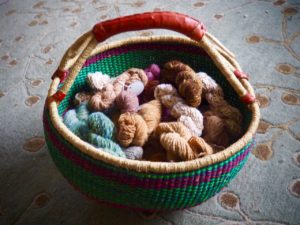
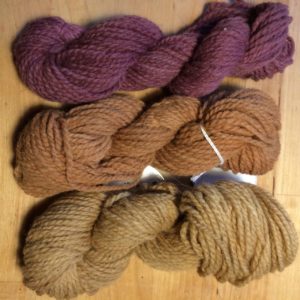

December Garden Tip: Give the Gift of Seed
December and January are quiet time for Bay Area gardens. As the soil regenerates with the scant seasonal rain, it is time to peruse seed and plant catalogs as you dream of spring. Seeds are a great gift to yourself and the world and these days we have a bounty of places to purchase from. If you are going to give the gift of seeds, consider projects and catalogs that promote sustainability and give back through their work. Here are a few seed outlets I endorse
Seed Savers Exchange biggest seed sharing network in the US, Dedicated to protecting and researching heirloom varieties.
Baker Creek Active since 1998 they are the founders of the Sonoma County based Heirloom Expo
Southern Exposure A worker owned cooperative with many “new heirloom” and rare seeds bred by contemporary seed smiths
Adaptive Seeds A newer seed project promoting biodiversity and featuring short season varieties adpated for the PNW and coastal climates
The Living Seed Company Founded by friends from my puppeteering era, this local north bay company offers some really nice collections that make great gifts
Seeds From Italy Seed packages containing Italian heirloom and standard varieties are generous—great for anyone who wants to grow a production level of veggies.
News From the North
Last months achievement included major learning curves as we finally contracted with a local company to take down two ginormous dead trees which needed removal so they wouldn’t fall on telephone lines or buildings. Who knew there were so many considerations and different ways to do it. The company we ended up going with was light on equipment (no boom or chipper) instead using a climber to top the tree and then fell the remainder. Check out a short video of the most exciting part here. Clean up was major, taking days to chop firewood, burn trash bark piles and so on. And thanks to my partners persistence, we also got a guy with a mobile mill out to make some lumber. We still have one giant log to deal with and are hoping for more lumber. Now in between downpours we are inching along with projects…trying to finish up a new poultry pen and start working on our sheep handling area, starting with a new fence-line and fence-line feeder. Our coop, pictured in progress below is a U-shape, with a covered entry, 3 separate pens and a storage nook.
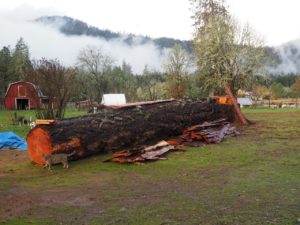
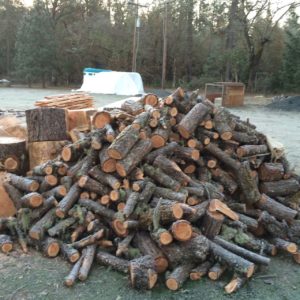



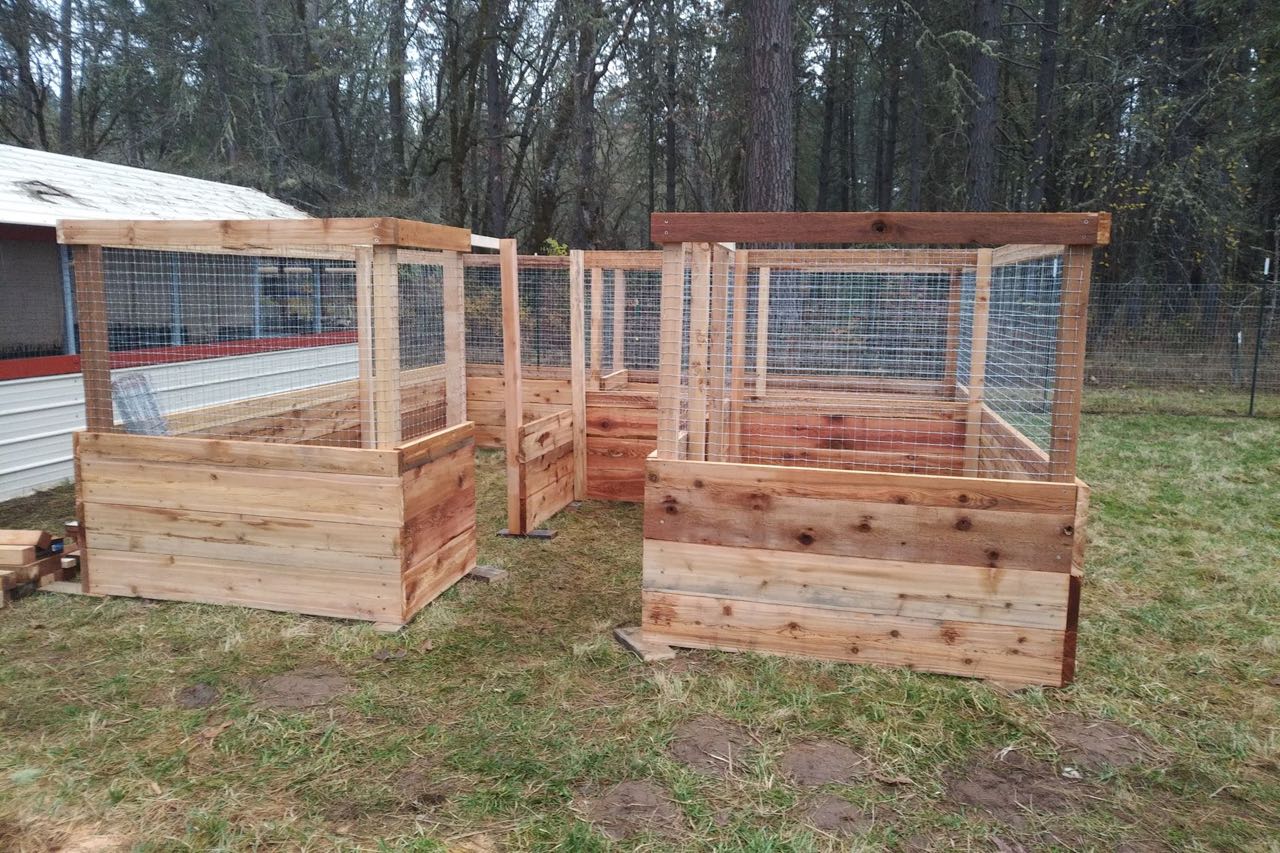
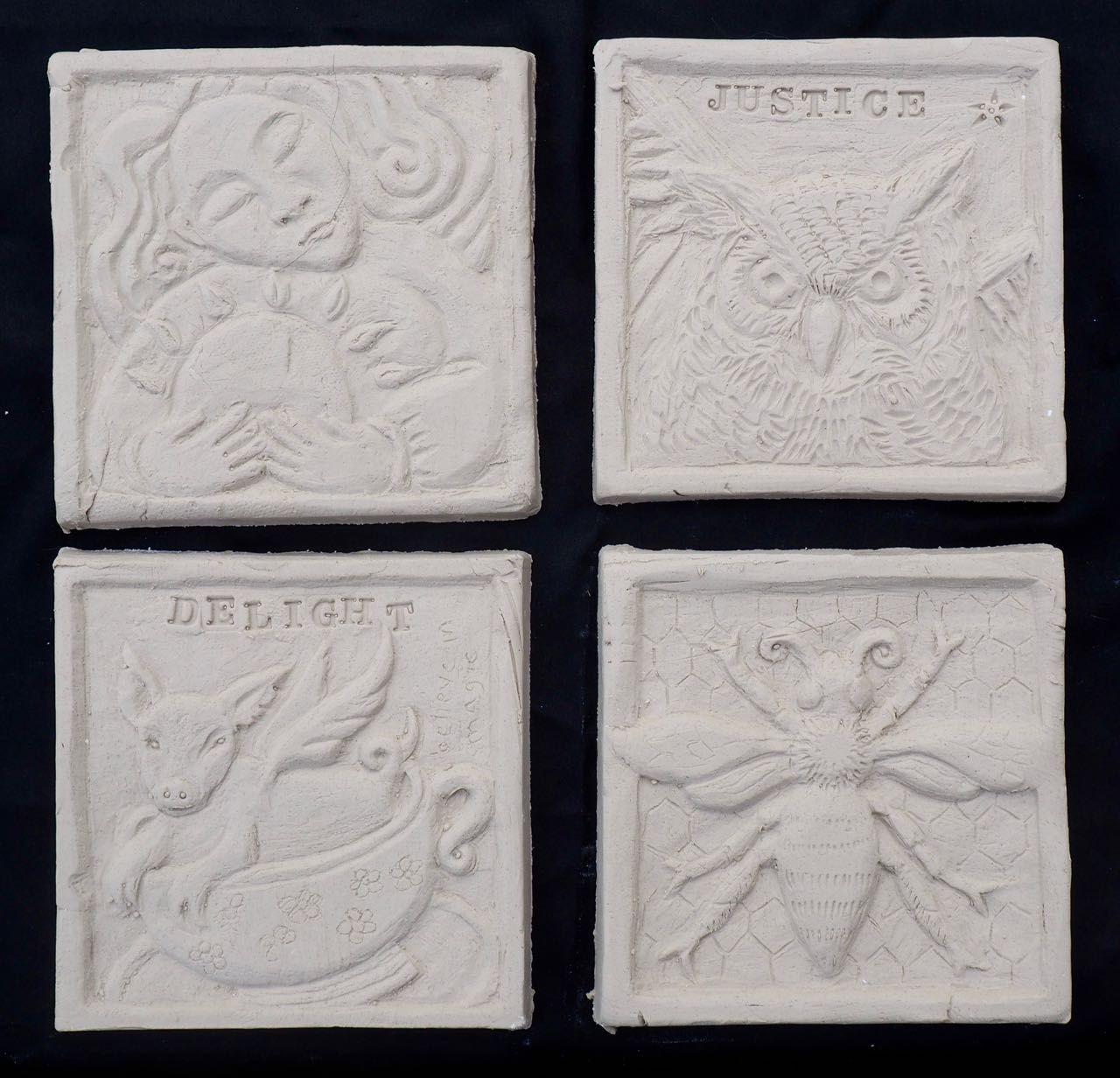
NOVEMBER
Happy Halloween and Day of the Dead! This is the magnificent time of year when the veil between the worlds grows thin…a time when the seasonal garden wanes and the cycle of life and death stares us in the face. All things that live must die…and it is starting to be time for another transition. The times are changing. When I started IUH in 2008, there was a real lack of agricultural skills education in the Bay Area and no organization was offering such diverse learning opportunities under one umbrella. People were just starting to think about growing an urban garden, learning to can or ferment or make a tincture. Home cheesemaking was a distant fantasy. The excitement for such things was palpable. Now there are dozens of projects offering similar educational possibilities (see my list below) and Bay Area folks are stretched thin trying to keep up with the difficult rental and housing market. I recently opened a discussion about this on a local homesteading list. The same query is posted below—join the discussion!
 Autumn Sunset
Autumn Sunset
WINTER OPEN HOUSE ~ LOCATION STILL NEEDED
Winter Open House!! Saturday & Sunday, December 15 & 16 12-4pm
I still need a location for my winter open house. It is a BIG ask. All day Friday for set up plus 12-4 both days of the weekend. I need two large rooms and possibly a kitchen. The location should be pretty central and accessible by public transport and bicycle. I can offer one or two of the following in exchange 1. A homesteading consultation (value $150) 2. Some amount of cash 3. A large goodie bag 4. A large audience to sell your own goodies or promote your socially relevant project. The dates are December 14 set up, Dec 15 & 16 12-4, plus clean up Sunday.
THE FUTURE OF IUH
IUH is going into semi-retirement. I will myself continue to teach a handful of weekends through the IUH each year, but there will not be a giant offering of classes from multiple teachers. You can plan on seeing the following classes offered at least once in 2019. Gardening 101, Introduction to Natural Beekeeping, Fermentation:The Works, Canning Extravaganza, Lather 101: Home Soap Making, Urban Orchard Intensive, Backyard Chickens. The first weekend of classes in late February is already on the Calendar If there was a class you have really been hoping to take that you wish I would offer, feel free to ask and I will do my best. Private classes and lessons will be available by arrangement (see below).
URBAN FARM TOURS 2019
I am thinking about a “Best of the Urban Farm Tours” event. I don’t have a date yet. Probably July or late September. It will mostly be what it sounds like—a Best of, but there will be a few new sites and there is still an opportunity to participate. It is a paying gig so if you have a little homestead you think should be featured please don’t hesitate to be in touch.
RESPONSE REQUESTED
What is going on there with urban homesteading/urban farming in the bay area? Is it still going strong?
Are people burnt out? Has the fad faded? Are folks just overwhelmed? All moving to the country? Is there something else on the rise?
I know there are a few of you still actively gardening and raising animals…I’d like ta know who y’all are and your appraisal of the current scene, including current issues facing you as homesteaders or wannabee homesteaders—for example if you still are interested/excited but something else is getting in the way. Excerpts of responses will be published next month.
NOVEMBER CLASSES
Last class offerings until Feb 2019! Get it while you can!
Saturday November 3, 1pm-4pm Homemade Snacks for Vitality
Friday November 9, 7-10pm Homestead Holiday Gift Making Party: Infused Vinegars, Oils and Honeys
Saturday November 10, 10am-1pm Hands Off! An Introduction to Beekeeping with the Warre Hive
Saturday November 10, 2pm-5pm Wine from Honey: Making Mead, Metheglin and Melomel
Saturday November 17, 11am-2pm Backyard Mushroom Cultivation
DECEMBER
Winter Open House!! Saturday & Sunday, December 15 & 16 12-4pm Location TBA
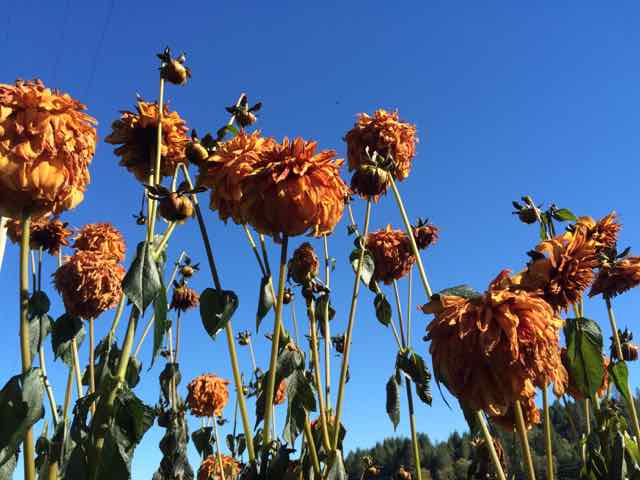
DAH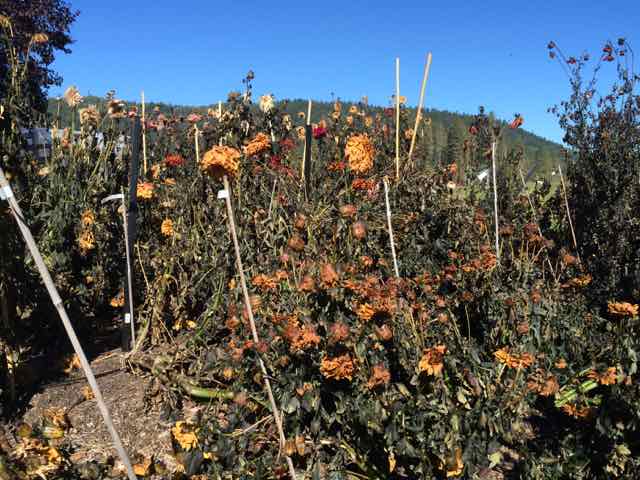 Dahlia Garden After A Hard Frost
Dahlia Garden After A Hard Frost
NEWS FROM THE NORTH
Our first hard frost came later this year than last. Instead of October 1st, we enjoyed our dahlias through mid month when freezing nighttime temperatures came to our little valley—even while daytime temps continued into the 80s! Over the course of 3 nights, it was all over with the garden. Dahlias, peppers, tomatoes, zinnias and basil all frost burnt and dead. It gave me a new appreciation for the concept of cold and warm weather crops as the lettuce, peas, cole crops and beets are still plugging merrily away. While my partner is wondering about extending the season with greenhouses and frost cloth, I am mostly happy for a break from growing (and processing) and the opportunity to focus more on clean up and infrastructure…After we get the damn dead trees felled and cleaned up (130 foot douglas fir and a 70 foot cedar, arg) we hope to build a poultry house and sheep handling area with a shearing shed. Beyond that a rustic outdoor bathhouse is in the planning stages, as well as a screened multi-purpose room for teaching, fruit and meat processing and more. The cider apple orchard will get filled in over the winter and hopefully a row of elderberries planted. Lots on the list, too little time.
NOVEMBER GARDENING TIPS
I give the same gardening advice every November, but it is a good one, so bears repeating, year after year:
It’s Garlic Time!!While November is mostly quiet time for Bay Area gardens you can still get your garlic in the ground in the next couple weeks. If you forgot to buy specialty heirloom garlic, any old grocery store variety will work fine. Unless it says different, most garlic in stores is a variety called California Early. Just break apart the garlic head into cloves, leaving the papery wrappers on. The pointy end goes to the sky, the rough end where they were connected, towards the earth. Plant 6” apart and 1-2 inches deep. You don’t even have to water it—the rain will start it growing. Later in the spring water normally with everything else. Ready to harvest when the outer leaves start to dry and die in June. Once you harvest, let it air dry to cure for a week or two before storing. And for next year, check out my favorite garlic supplier, Filaree Farm, and get yourself some fancy heirloom garlic—order in the spring, receive it in the fall in time to plant.
SERVICES
As I transition out of producing public workshops, I am looking to continue to offer my skills to the greater community.
~ Garden/Homestead Consultations Confused about design, implementation or just want feedback on your direction? A site visit includes a walk and talk lasting about 1.5 hours, plus follow up emailing to make sure you got everything down in your notes. I have some availability in November!! $150
~ Llama, alpaca & sheep shearing WeLoveSheep.com I realize this is less pertinent to most of you city dwellers, but my partner and I are working on growing our shearing business, so if you know folks with sheep or camelids, feel free to direct them to WeLoveSheep.com.
~ Natural Treatment Free Beekeeper Mentoring I am still working with bees and have 20+ years experience with natural beekeeping in a variety of hive systems. While I am not available for emergency house calls, I am still available for distance mentoring. For a small fee each month I offer unlimited phone and email support, plus site visits as available in the Bay Area and North. General cost is $75/mo with a 3 month minimum commitment.
~ Private Lessons, Parties and Classes. I can teach and advise on a whole slew of homesteading skills and topics!! Private lessons $75/hr. Private Classes $300-400 depending on topic and number of participants.
For an idea of topics and pricing check out this page on my Oregon site. Bay Area prices are 10-20% higher. https://rogueriverreskilling.com/house-parties/
OTHER PLACES TO LEARN
Homestead Apothecary https://homesteadapothecary.com/
FarmCurious https://www.farmcurious.com/
PLACE https://aplaceforsustainableliving.org/
Preserved https://www.preservedgoods.com/learn
Pollinate Farm & Garden https://www.pollinatefarm.com/verlocal-calendar/
Biofuels Oasis https://biofueloasis.com/
18 Reasons https://18reasons.org/calendar
Sour Flour http://www.sourflour.org/workshops/
Brew It Yourself https://brewityourselfsf.com/
 Experiments in Natural Dyeing ~ Hand spun yarns will be available at the Winter Open House!
Experiments in Natural Dyeing ~ Hand spun yarns will be available at the Winter Open House!
OCTOBER
Hello Peoples!
The Fall is upon us. Shorter days, cooler nights and even a little bit of rain. As we start to roll around the seasons, it is time for harvesting winter squash, apples, pears and grapes. We hope the Fall brings an end to the spread of wildfires, cleaner clearer skies and holiday celebrations. Join us at IUH for our holiday gift making series and recommit to simple sustainability hacks.
Classes!
We have a fab weekend of classes coming up October 5 & 6, holiday gift-making, hand sewing, seed saving and cordials & bitters—If you want to attend please register ASAP as the deadline for them to happen is coming up quickly, And please note that the dates for two October classes, Backyard Chickens and Kitchen Alchemy have changed.
Garden Design Consultation
I am available to come to your garden or burgeoning homestead and consult you on site design, soil preparation, fruit tree placement, coop placement, compost and a host of other topics. We start with a tour of your place, explore your ideas and desires and come up with a solid plan for moving forward. Consultations usually last about 1.5 hours with a follow up email exchange to review your notes and plan. Cost is $150. I may have some time this upcoming weekend. Let me know of your interest!
Urban Farm Tours 2019 ~ Locations sought
Seeking locations to participate in Urban Farm Tours 2019.
We look for sites where people are growing food (veggies, fruit, meicinal & culinary herbs), raising animals for food (rabbits, chickens, goats, bees) and employing sustainability features (natural building, composting toilets, rainwater catchment, drought tolerant gardening, pollinator gardening, composting, worm composting, creative economics, aquaponics, hugelkultur, container gardening, food forests, mushroom cultivation and etc. We look for people who are good talkers and who love to promote their lifestyle. We look for sites ranging from micro postage stamp to about an acre. Focus is Berkeley Oakland but other areas will be considered. This is a paying gig, admission is charged and each farm gets a cut of the proceeds. If you are interested in being considered please respond with the following I will be doing site visits this Fall.
1. You name, phone number & email.
}2. The name and address of your “farm”
3. The size of the lot and the size of the farmed area
4. A description of the site and the features
5. A note about what you are most passionate about sharing with the public about your site
6. A few pictures
SEEKING LOCATION FOR WINTER OPEN HOUSE
Seeking a fabulous location for my beloved winter open house. If not a home, perhaps a local studio space—not too spendy? The dates are december 15 & 16 12-4, plus it usually takes a full day to set up the Friday before. In terms of a home 2 large rooms usually fit me and my stuff— a living & dinning room or dining and kitchen…something like that. I can pay some money or give a big box of goodies from the sale and/or offer a garden consultation.
Let me know if you are interested or have ideas for me!!
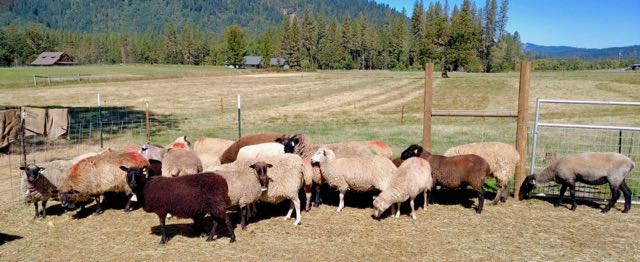 News From the North
News From the North
Our first rains washed the smoke from the sky and the fabulous Fall is here. I think it is my favorite time of year here. Pleasant days, cold nights, dewey mornings…. still harvesting an abundance of peppers and grapes, processing the pear harvest and wondering what to do with all that basil….for now the bees are enjoying it at least! The dahlias are still putting on a fantastic show as we stockpile winter feed for our critters and repair and reinvent winter shelters. Our Blue Faced Leicester ram is forced to wear a marking harness this year, so we known when our ewes get bred and he seems to be doing his job as we see one or two more rumps marked up with red crayon each day. The freezers are well stocked with lamb, beef, chicken and rabbit, as well as pouches of pear and apple juice. I am enjoying spinning on a brand new Lendrum spinning wheel and I am looking forward to being done with processing fruit for the year!
October Harvest Tip ~ Pears
Most pears do not ripen on the tree and need to be picked when still quite firm. Pears picked when slightly immature will ripen with better quality than pears that are over mature when picked. Ready to ripen pears will detach when “tilted” to a horizontal position from their usual vertical hanging position. Bosc pears always are difficult to separate from the spur. Once pears are picked they should be chilled and stored at about 30 degrees F. Bartlett pears need to be cooled only for a day or two, and winter pears such as Anjou, Bosc and Comice require 2 to 6 weeks-in my experience 3 weeks will usually suffice. Once removed from the fridge, or brought home from the store, ripen at 65 to 75 degrees F for the following times: Bartlett, 4 to 5 days, Bosc and Comice, 5 to 7 days; and Anjou, 7 to 10 days. How do you tell when a pear is ripened to perfection? Hold the pear gently but firmly in the palm of your hand. Apply the thumb of that same hand to the pear flesh just below the point where the stem joins the fruit. When the flesh beneath your thumb yields evenly to gentle pressure, it is time to eat your pear. If you have to push more than slightly, it is not ready yet. Enjoy!!
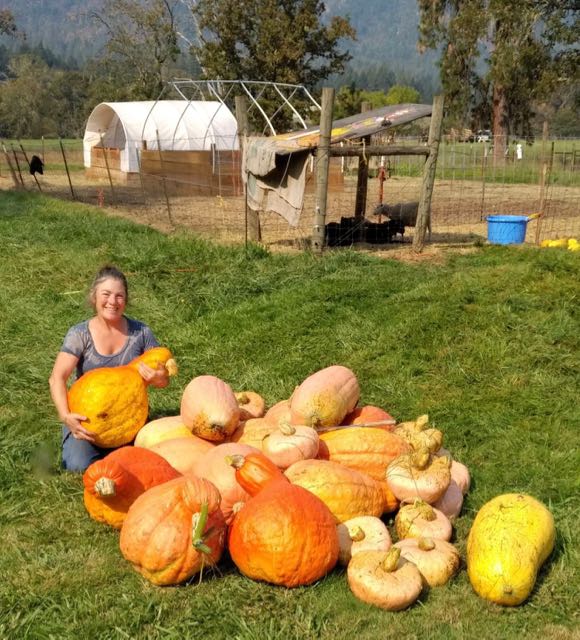
SEPTEMBER
Hello Dedicated Readers and Learners,
It is hard to believe it is September already. The summer here was filled with fire and other dramas. But the skies are currently blue and the harvest is abundant. We have some class offerings for you, and hope to add a few more in the next weeks.
Fall Calendar!
This fall we are focusing on homemade gifts and self-sufficiency hacks. We’ve got some fun new classes and of course a few old standards. We are welcoming Alexandra Hudson to our faculty. Housemate to Jeannie MacKenzie, who has taught backyard chickens class since year two, Alexandra offers the perspective of Food As Medicine to the compendium of super homesteading skills. Please remember to register early as classes that don’t have a minimum of 5 registrants 5 days before the class can cancel.

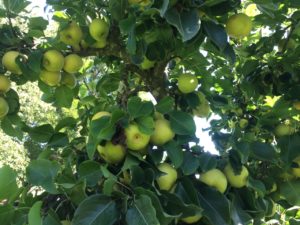
Seeking Hosts for Classes and Winter Open House
The following classes are homeless and looking for homes. Spaces need to be able to seat 10 comfortably. It is awesome if you can host for a full day, but depending on location also fine to sign up for just one class. Hosts attend for free. I am also looking for a suitable location to hold my Winter Open House (December 15 & 16, 12-4pm, plus the Friday before for set up)
Saturday October 6, 10am-1pm Self Sufficiency Series: Hand Sewing Basics
Saturday October 6, 3pm-6pm Homestead Holiday Gift making Party: Salts, Scrubs, Salves and Slathers
Sunday October 7, 10am-12 noon Self Sufficiency Series: Seed Saving
Sunday October 7, 3-6pm Homestead Holiday Gift Making Party: Cordials, Liqueurs and Bitters
Preserving the Harvest: Raw Pack
Raw packing fruits and vegetables for water bath canning is one of the quickest and easiest ways to can. You will need clean jars, half pint, pint or quart. For fruits, slice and pack into the jars and cover with boiling water to 1/4 inch from the top edge of the jar. Add 1-3 Tablespoons of sugar or honey and screw the lid on. Check the process time– google “water bath canning raw pack (name of fruit)”. Place in a pot and fill with water to cover jars. Heat until the water boils. Maintaining the water at a rolling boil tart counting your process time. At the end of the time, remove the jars from the water and let sit until cool. For vegetables, cut and pack raw vegetables into the jar. Cover with a vinegar based brine to 1/4” below the rim of the jar (you must use a vinegar brine or the vegetables won’t be safe). For your brine use 1 part vinegar to 3 parts water. Add sugar salt , herbs and spices to taste. Screw your lids on, place jars in a pot and fill with water to cover jars. Heat on high until it boils. Let boil for 10 minutes. Then remove jars and let sit to cool. For best results let these sit for 2 weeks before use to let the flavors develop.
News From the North
Summer? What summer? In July we evacuated all our animals plus important equipment, tools and vehicles as the Taylor Creek fire came within a half mile of our property. The firefighters worked non-stop here to protect homes and communities and not one building burned. The Klondike Fire grew to connect with the Taylor Fire and the two together are now close to 200,000 acres and classified as a megafire. We had weeks of white out visability and hazard level air quality. Then, in August, my greatest fan and supporter passed away suddenly due to an aggressive infection which attacked her heart. My mother, Jacki Fox Ruby, 80, was an amazing school teacher and tireless union organizer. There will be a memorial for her in Berkeley at the end of the year.
In brighter news, our fruit trees have produced an amazing amount of fruit this summer due to our efforts to properly prune, irrigate and treat for disease. We have had beautiful harvest of Ubileen, Comice and 20th Century Asian Pears, buckets and buckets of apples and European prune plums. A bumper crop of cucumbers was more than we ourselves could handle, so our rabbits have been well fed. The hot peppers and basil are still going strong and we are getting ready to breed our sheep. My partner has steeped himself in the world of cover crop and flood irrigation—exploring broadcast seeding our pastures for forage diversity for sheep and bees. I have learned about crops I had never heard of before, such as sunhemp and sainfoin. The heat is finally abating, the skies are clearing and we are looking forward to a productive fall.

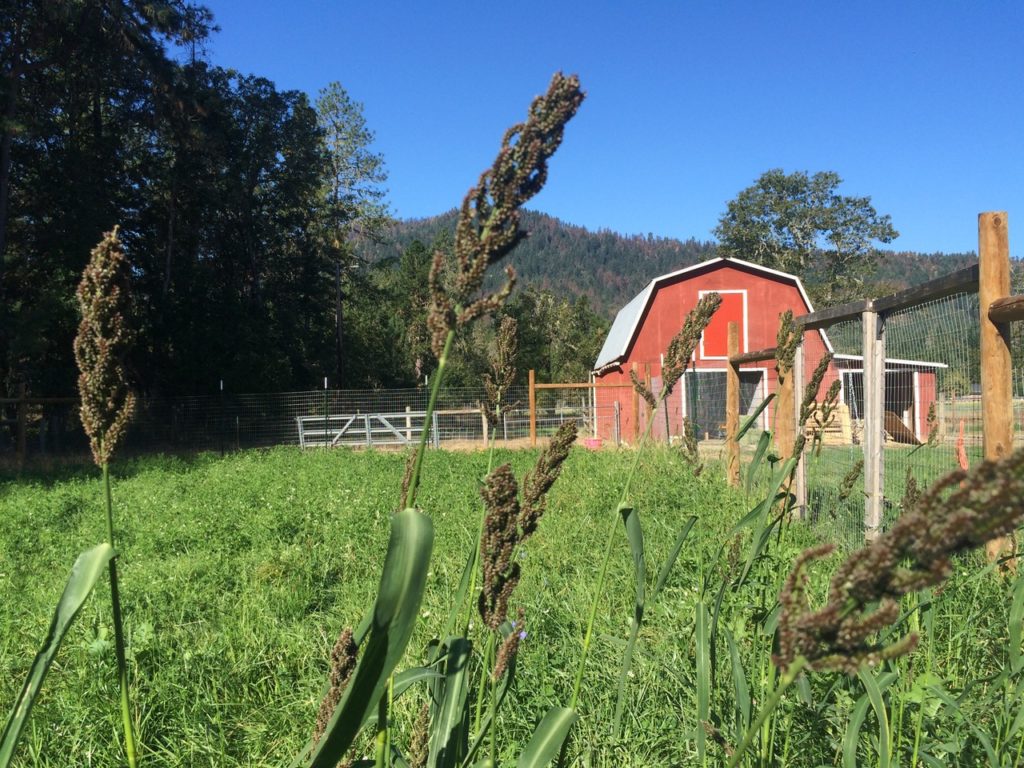
Looking towards the Future ~ Farm Tour Frenzy?
The IUH Farm Tours were much beloved and many have asked me for an encore. It has been hard to wrap my mind around producing them from afar, but for 2019 I am exploring the idea of offering fewer classes and instead producing one or more farm tours. Are you passionate about promoting the homesteading lifestyle to your friends, family and community? Do you have a homestead that is unusual or particularly well developed?
We look for sites that have a garden, livestock, water conservation, orchard or other self-sufficiency features in a variety of sizes from postage stamp to extra large. We have featured farms that have food production businesses, food forests, extensive rain catchment, pollinator gardens, aquaponics, vertical gardening and more. I will likely stay focused on Berkeley and Oakland, but if you have an outlying homestead you think is special, let me know. To submit your place for consideration, please send the following:
Your name & contact info (email, phone).
The name of the farm (if any) and the address.
A description of the site and its features including size (acres/square feet) if possible.
A few photos that show the property and its features.
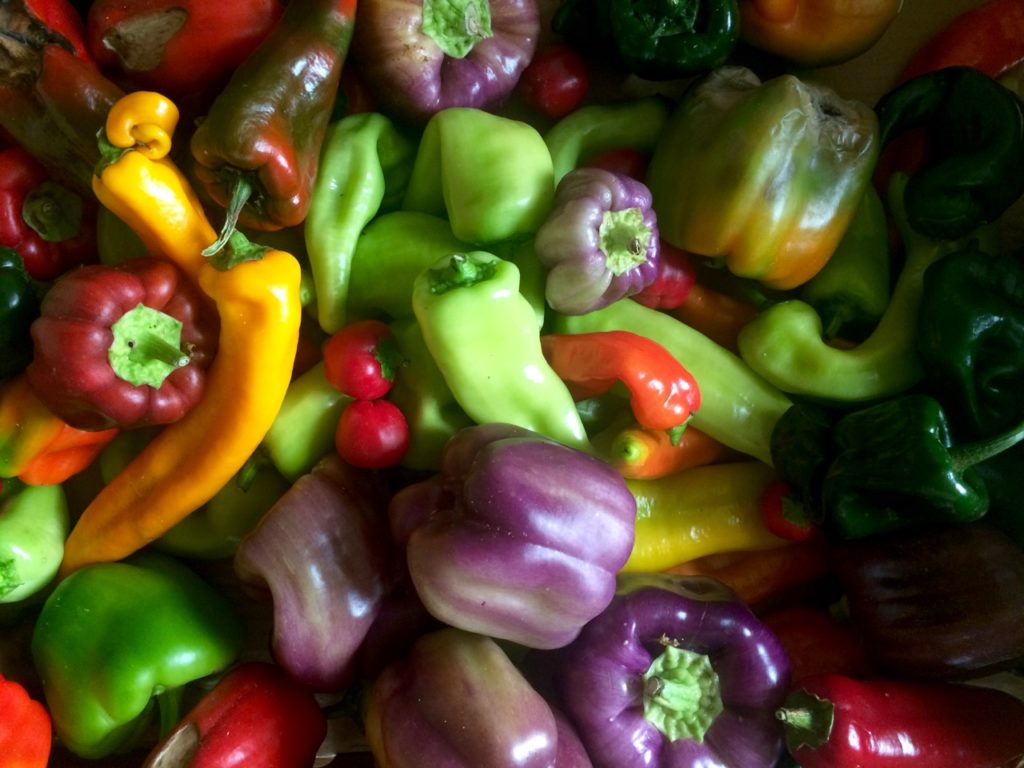

SUMMER ~ SHORT & SWEET
Things sort of fell apart and haven’t quite fallen back together again. Website issues, teachers off the grid and general strangeness of the times. I know it is not very confidence inspiring when you don’t hear from us and when there is not a full offering of classes. I also get the sense that people are busy and swamped with places to go and things to do. Truth? I am curious to know what is going on out there in the minds of Bay Area Homesteaders and Wanna-be homesteaders. In the meeantime our summer season is SHORT & SWEET— two weeks in the beginning of August and a small selection of standards and new offerings. We hope to be able to offer a good selection of Fall classes September 16- November 12. If there are things you want to learn or things you have to offer please let us know!!

Garden tip: What is that white stuff on my pllant?
Cool Bay Area summers with the foggy mornings and evenings are conducive to several plant pests including Powdery Mildew and Downy Mildew
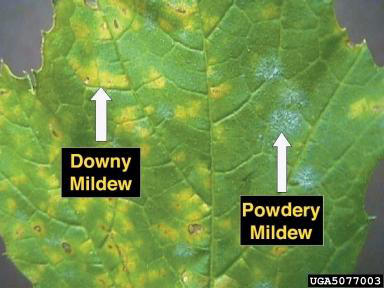
Powdery mildew, caused by the fungus Blumeria graminis, is an an obligate parasite that grows only on living tissue. PM is a problem in areas of high nitrogen and cool, moist weather conditions. Optimum temperatures for development of powdery mildew are 59 to 70 degrees F, like our coastal summers. Although we don’t think of california as humid, the foggy nights and morning along with the perfect temperature makes this fungus a pest, especially on cucurbits ( squash). The most noticeable symptom of powdery mildew is the spots or patches of white powder that can be found usually on the leaves. These spots enlarge and become a dusty white or gray coating. Downy mildew refers to a number of different bacteria in the family Peronosporaceae. They also love cucurbits, but also grapes, peas and other vining vegetables. Downy mildew can look at first glan
ce,like nutritional deficiencies as leaves become yellowish or speckled. Leaf edges may curl downwards, and faint gray fuzz may appear on the undersides of leaves. As the disease progresses, white-ish to gray, downy-looking growth will be visible along the undersides of leaves, sometimes flecked with tiny black spots. On the upper surface, yellow leaf spots will appear angular in shape and bound by leaf veins, sometimes creating a “quilted” look. Eventually leaves and flowers drop, leaving you with a plant of mostly stems. Basils, impatiens, melons, and viburnum are particularly susceptible to downy mildew.
Solutions? Remove the affected leaves and dispose of—not in your garden compost! Burn or send to the dump. Spray healthy leaves with compost tea and/or a solution of tobacco tea and neem oil. Keep moisture off the plants. Water at soil level (drip) or if you must water overhead, only in the morning to give plants a chance to dry out during the day
News From the North
The garden is in, the sunflowers are blooming and I am harvesting zukes, cukes, onions and potatoes. The first tomato ripened in my little greenhouse too. Yum! I knocked out large batches of strawberry and cherry jam and still 6 gallons of cherries remain in the freezer waiting to be processed into dried cherries, shrubs and juices. The first dahlias, zinnias and gladiolus are blooming and things are looking cheerful. We have got lots of babies on the farm, a kitten, 20 meat chickens, 2 bantams, a few baby pigeons. . The sheep are on the pasture and the lambs are growing. I am battling bindweed and it is a loosing battle at best, but I will go down fighting. The two local swarms I have are getting established and I am hopeful for bees that mnake it through to 2019. Fingers crossed. I recently bought a spinning wheel and have been spinning like crazy—some raw wool and some etsy wool…exploring that world en route to harvesting our own fine wool fleeces for hand spinners. I have continued to slowly grow a shearing business and tam focusing primarily on shearing Alpacas. There is a large need here and it is fun to be out in the area meeting folks and seeing their farms.


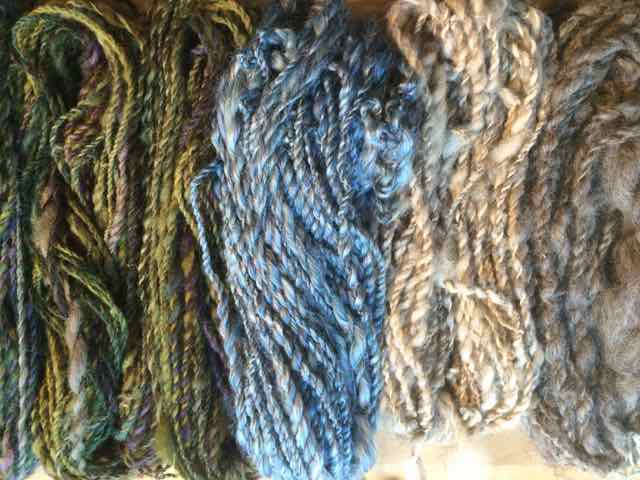
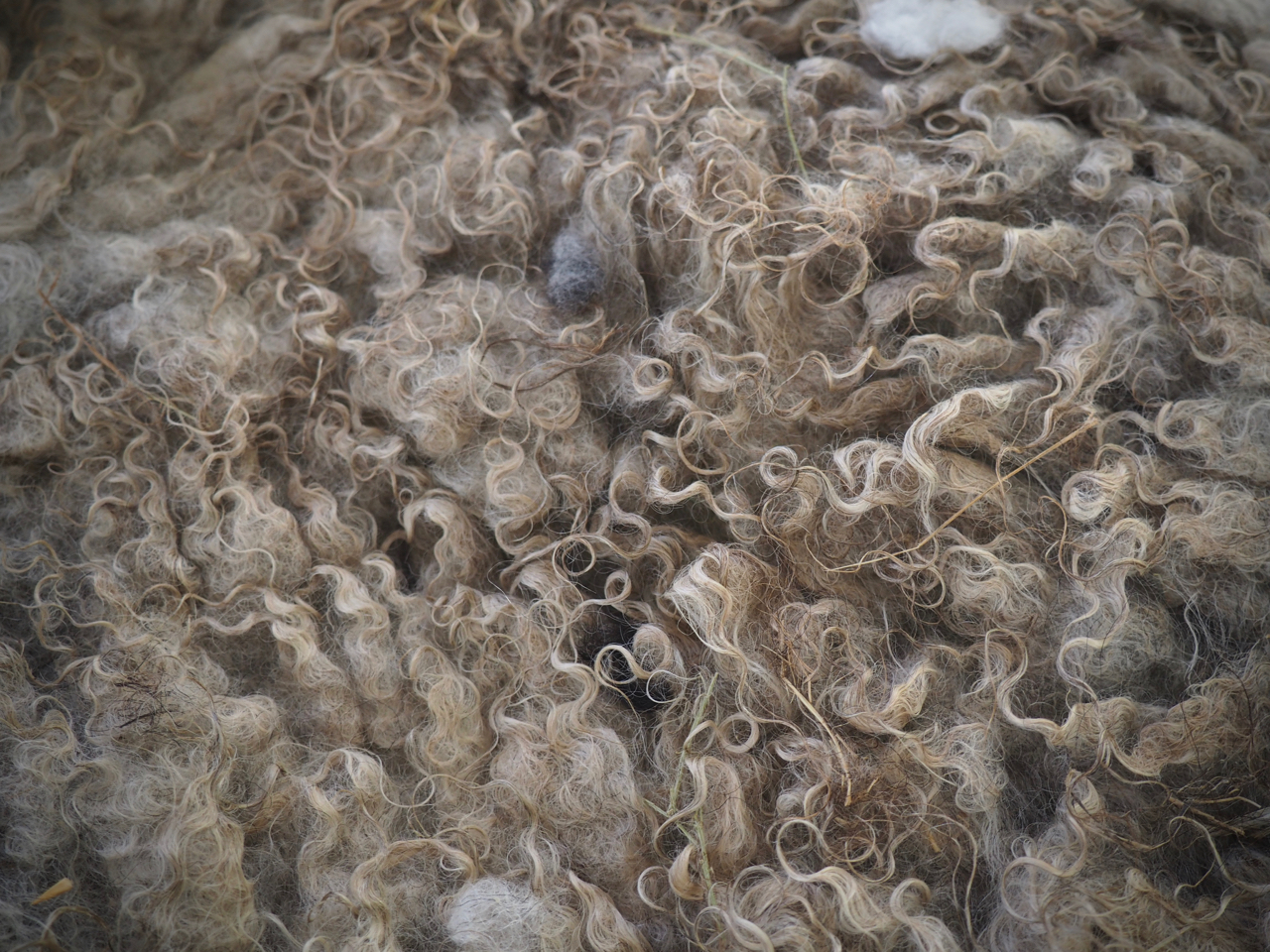
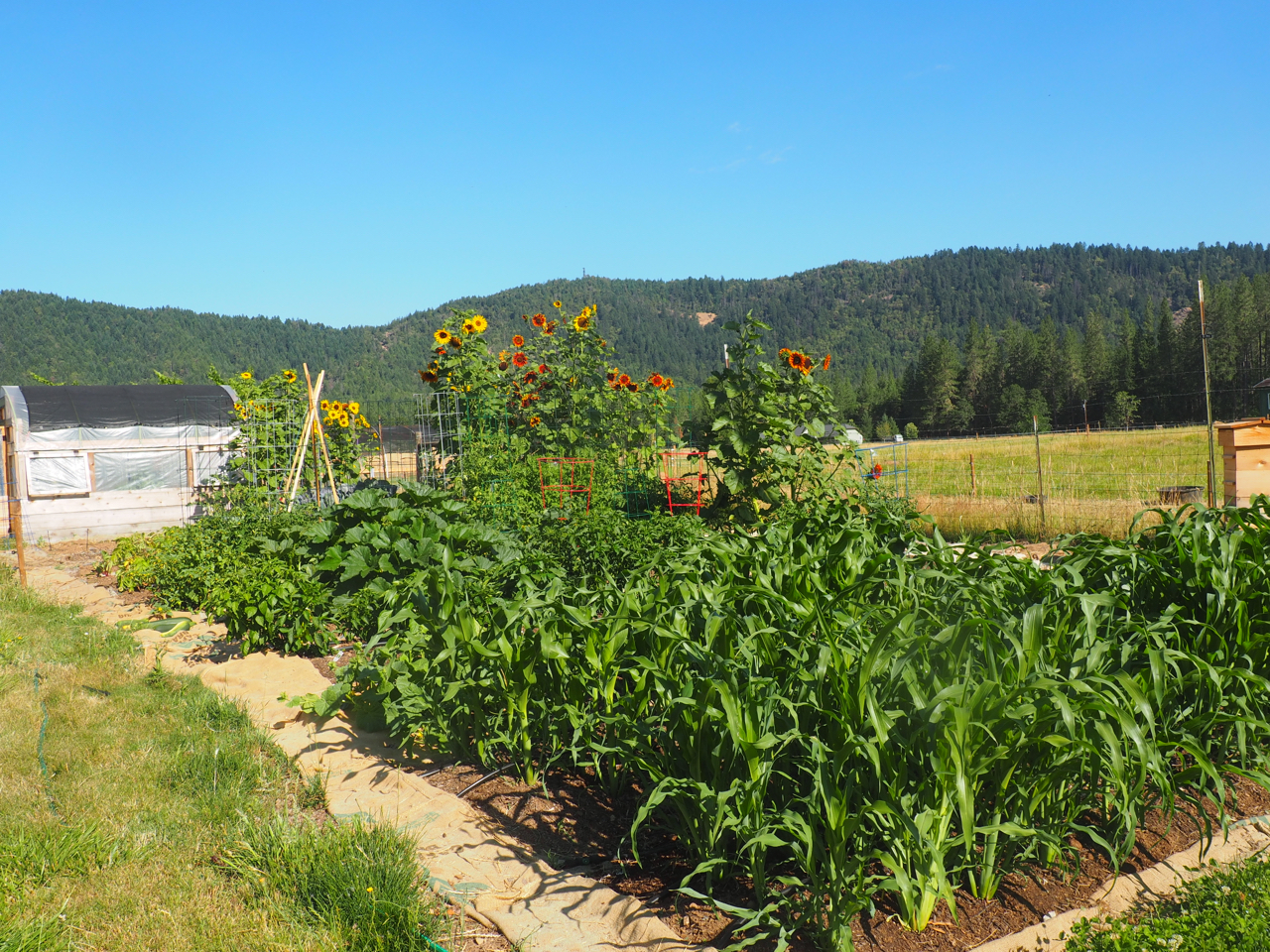
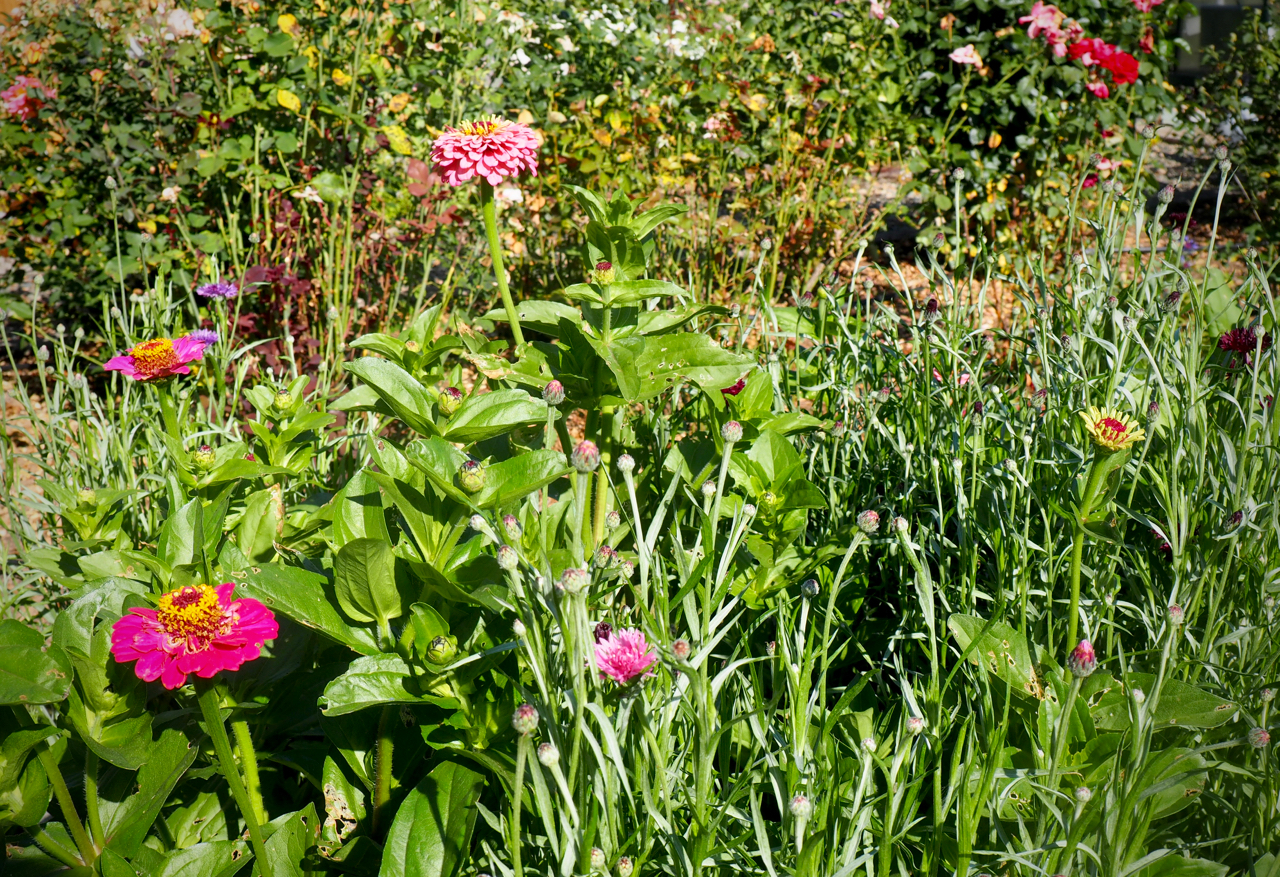
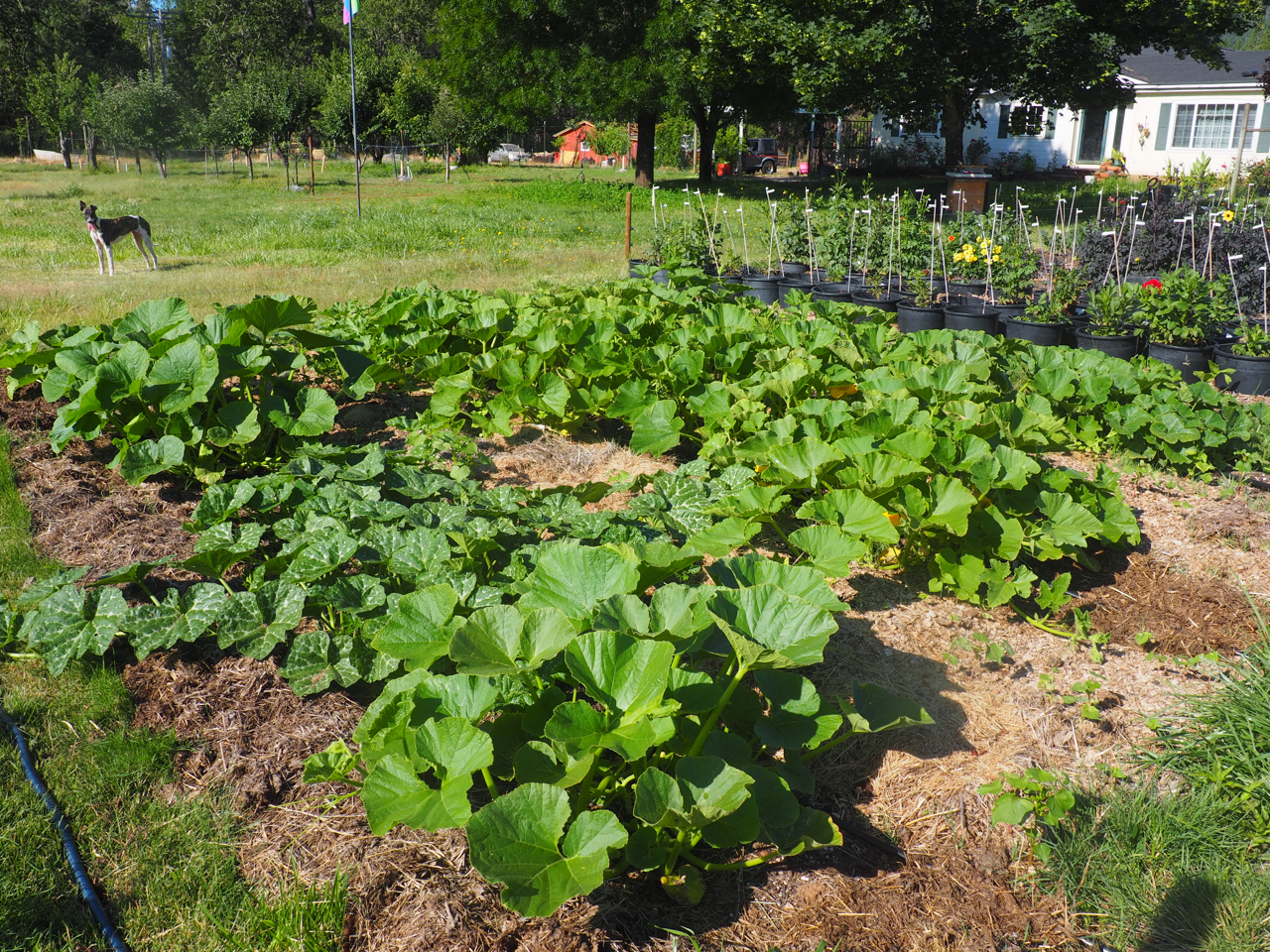
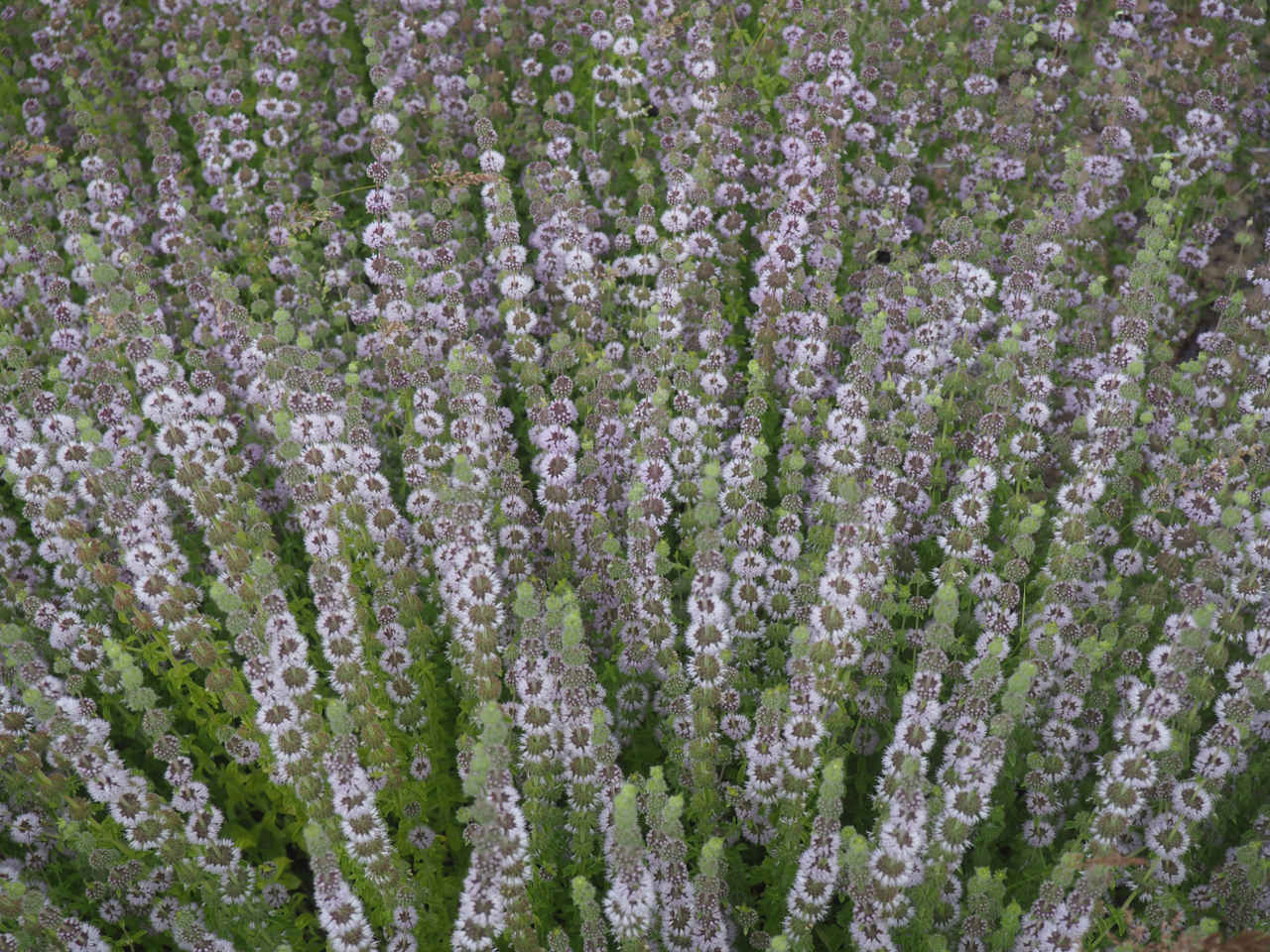
OLYMPUS DIGITAL CAMERA

OLYMPUS DIGITAL CAMERA
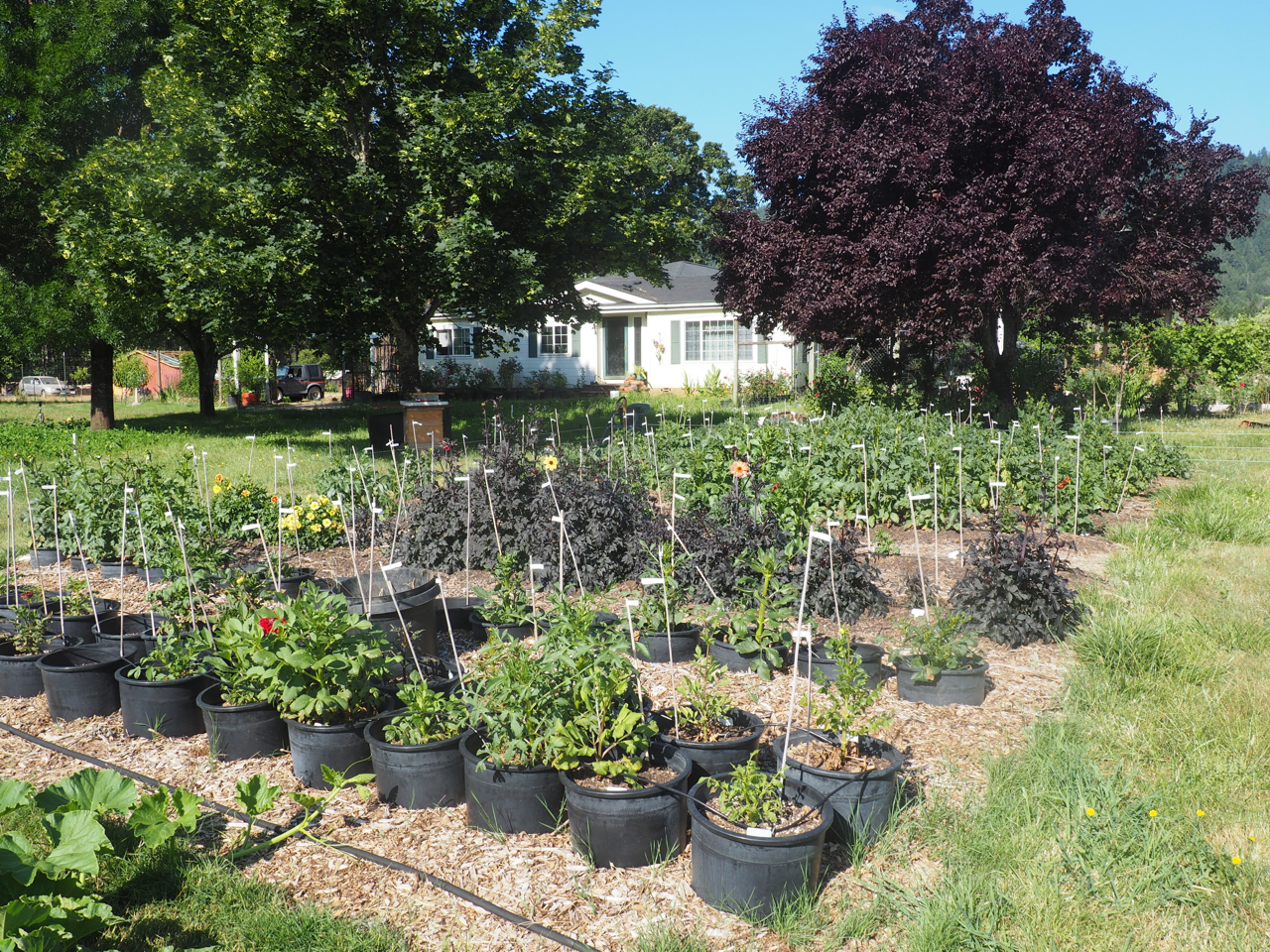
MAY @ IUH ~ GROW GROW GROW LEARN!
Hi Homesteaders
Happy May Day!! Add a little rain, then a little heat and voila—the grass grows and everything is gorgeous and green! I hope you are ahaving a wonderful Spring and I hope to see you in one of my classes later this month.
Homesteading Survey
Thanks to those who filled out our little homesteading survey…the results were not that surprising. While answers were pretty much all over the map, the scales tipped in on a fair number of you being female, 30s or 50s, urban, homeowners living on 1/10th of an acre or less. You overwhelmingly choose the lifestyle for fresh high quality food. You love to garden and compost, think it makes at least a little bit of difference and prefer to learn by doing. Here are all the results: https://www.surveymonkey.com/results/SM-J9TLN26VL/

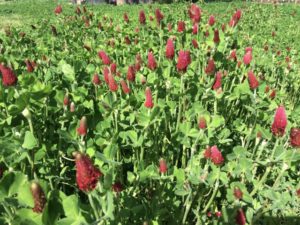
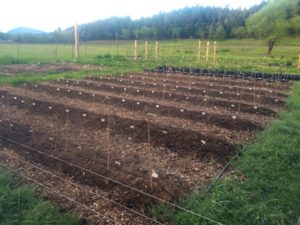
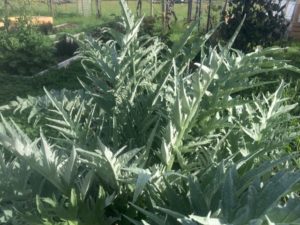 May in the Garden
May in the Garden
Go for it! Now is the time that most of your sun loving annual vegetables and flowers can go in the ground if they haven’t already!! The cool season crops such as peas and kale may struggle a bit from here on out, so now it is time to focus on tomatoes, summer and winter squash, salad greens, cucumbers, beans, beets and carrots. Marginal crops for the cool east bay summers are eggplant, melons, corn, okra and peppers. Plant these in the warmest spot in your garden. Okra and sweet peppers both love water and humidity. They can be grown in a green house or need a drip system. Hot peppers tend to do well even outside. It is late to start tomatoes and peppers from seed, so get those from your local nursery. if you missed the seed starting window. Most other crops can still be started from seed. For heat loving plants like corn and melons, try short season varieties. I have had success with Minnesota Midget and Green Nutmeg. Some other varieties developed for Northern Climates may also produce a few melons in the coastal climate. For corn, choose a variety that takes 60-70 days to mature and one that has a shorter stalk (5-6 feet instead of 7-8 feet). Corn must be planted in block!! Don’t bother getting corn as starts—definitely start from seed. Fold your corn seeds into a towel on a plate and soak them well. Let them sit moistened for 2-3 days until their root appears and then plant. Plant 4” apart in rows 8” apart. If using drip, plant a seed on each side of each emitter. Plant in a 4 x 4 or 4 x 6 foot block. They will send up their first leaf within 1-2 days. Once they have grown their stalks, the tassels will develop first, then the silks. When the silks appear you can “make like the wind” jostling the plants so they will release their pollen and get good coverage on the silks. Each silk will become one kernal!
A Brief History of MayDay—the Red and the Green
The Green: The first of May is associated with Beltane nd Walpurgis Night, European pagan holidays whose traditional celebration includes the Maypole and the crowing of the May Queen. May Day marked the beginning of summer and was when cattle were driven out to the summer pastures. Rituals were performed to protect the cattle, crops and people, and to encourage growth. Special bonfires were kindled, and their flames, smoke and ashes were deemed to have protective powers. The Red: On May 1, 1886, more than 300,000 workers in 13,000 businesses across the United States walked off their jobs in the first May Day celebration in history. In Chicago, the epicenter for the 8-hour day agitators, 40,000 went out on strike with the anarchists in the forefront of the public’s eye. This day was chosen as the date for International Workers’ Day by the Socialists and Communists of the Second International to commemorate the Haymarket affair in Chicago.
 News From the North
News From the North
We got baby cows last month and the lambs continue to trickle in, though we are hoping they will be done soon. We have cross-fenced our pasture to start rotational grazing and will see how it goes. Massive seeding projects on the pastures have not yet come to fruition…without a way to till we are depending on nature and luck for things to germinate. Fruit trees have sprung to life with abundant blooming and hoping for a good fruit set this season. More than 120 dahlia tubers survived winter storage and are in the ground. The summer vegetable garden is just getting installed, we are about a month behind you all in the Bay Area. And flowers have started to bloom, the tulips gave a good show and now it is on to foxglove,columbine and iris. The short but delightfully fragrant lilac season is upon us and the grapes are just starting to reach towards the sun.
Classes!!
We got lots of great classes coming up in May and June. Please do think of signing up early! This ensures that classes you want take place. Check out the CALENDAR for details.
We’ll be having a short summer session this year From July 15 to August 13 or so. Anything you want us to offer? Please let us know soon!
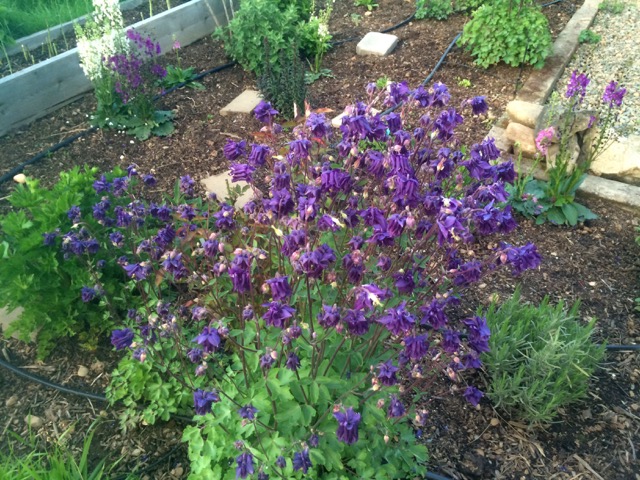
abundant columbine
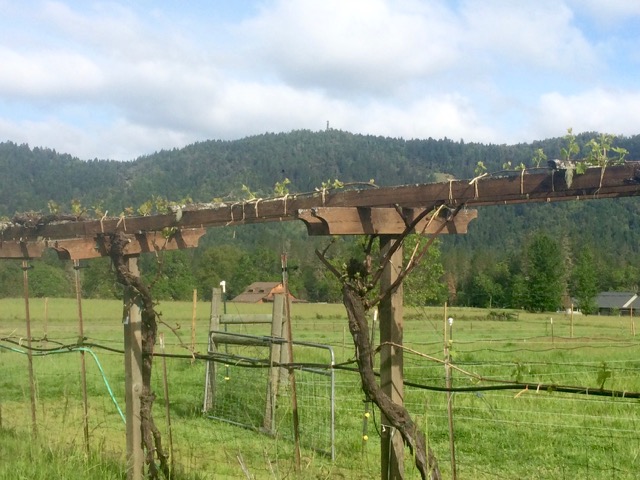
grapes begin to reach for the sun

yay for baby bunnies!
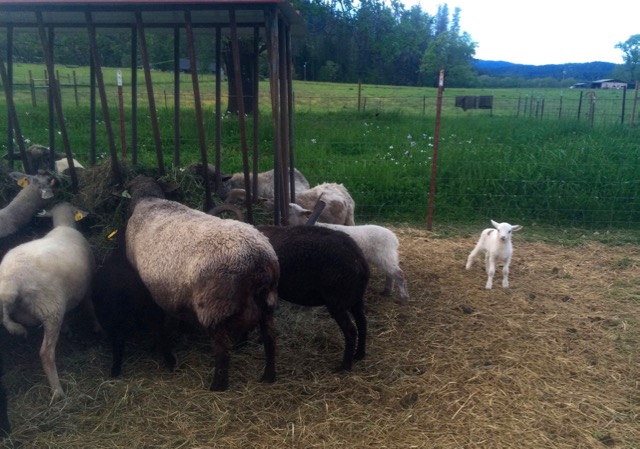
a wee lamb stands to the side at feeding time
APRIL at IUH ~ Jump in To Dirt!
Hi People!
We are over the hump! The days are getting longer and the Spring has definitely Sprung. Sending out our April newsletter a few days early here as I will be heading down to the Bay Area to teach a few wonderful standards this weekend.
Catch this weekend’s classes!
Sunday April 1, 10am-3pm The Real Dirt: Intro to Organic Gardening With a heavy emphasis on growing good soil this class is socked full of information for the beginning and intermediate gardener.
Saturday March 31, 10am-4pm Introduction to Natural Beekeeping with Top Bar & Warre Hives. A fascinating look into the world of honeybees and how to get started as a Natural Beekeeper. Suitable for people just wanting to know more about bees as well as those looking to get started in beekeeping.
And later this month some wonderful offerings from our own permaculture Chef Seth Peterson—see the list of classes below!
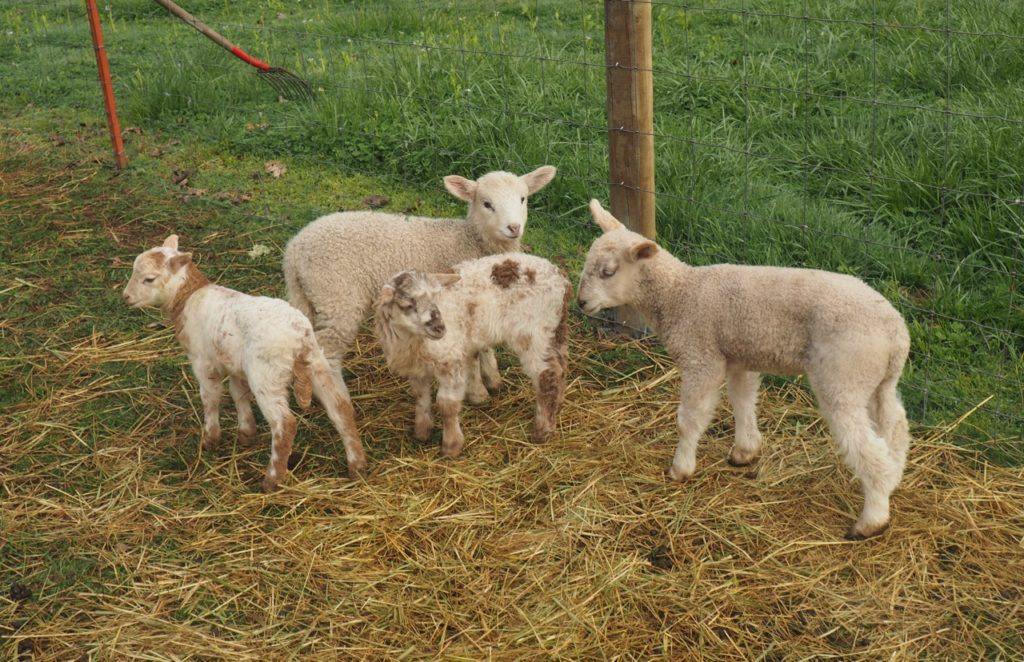
lambs in the field
Homesteading Survey
Do you like taking surveys? This one is just sort of for fun—I am sure lots is left out but still it might be fun to see how people answer. I wish it could be much longer and more thorough, but they charge a bunch for more than 10 questions—anyway it only takes about 5 minutes to fill and it will be fun to see how everyone answers! Will publish result in a future newsletter. Take the Survey
East Bay Diesel Project
A friend of IUH is working on this wonderful research project:
State health workers and UC Berkeley are inviting families to participate in a new project studying air pollution from trucks and other sources in Oakland, Richmond, and San Pablo. Families with young children can join the East Bay Diesel Exposure Project. We will give back individual results to families if they would like see them, and also give advice on possible ways to reduce exposures. All personal information from families will be kept confidential. To thank them for their participation, families will receive $80 in gift cards to a local store.
April Gardening: Snails and Slugs, ugh!
With all the recent rain, the slimy crawlies that like to eat your favorite spring starts are out in abundance. We’ve all heard about the beer trick…but does it really work? The answer is.…not so much. Over the years we’ve tried many methods and here are the top three:
1 Hand picking. By far the most effective means of knocking down the population and interrupting the breeding cycle. Tools needed: headlamp, yogurt container or jar with lid and chickens (yours or a friends). Every other night for two weeks, go out at night with your headlamp and hunt. Snails and slug crawl from their daytime hiding spots after dark and this is the best time to hand pick them off your plants. The best depository for them is to feed them to chickens ir ducks.Pick them off the plants where you see them and feed them to chickens or ducks. Don’t have any of your own? Use your Nextdoor Network to find a neighbor with chickens. Many of our local community farms also have chickens (spiral gardens, Urban Adamah).
2. Copper barrier. If you have raised beds, installing it with a copper barrier—usually a mesh around the top edge is a great initial deterrant. Once they are in the beds it is harder to get them out ( and the copper would unfortunately then keep them in). In regulr garden beds you can make rings to put around your new plants. buy copper sticky back tape (bulk on Amazon is way cheaper than in a nursery). Cut 1 or 2 gallon black plastic pots into rings. Cover the top edge with the copper tape. Shove the ring into the ground around the plant you would like to protect.
3. Eggshells. A good amount of crumbled eggshells scattered on your bed add micronutrients long term and will deter the slimies. In dry weather you can also try dusting with diatomaceous earth ( also high in calcium and irritaing to the slimier critters…but this washes away with rain or overhead watering.
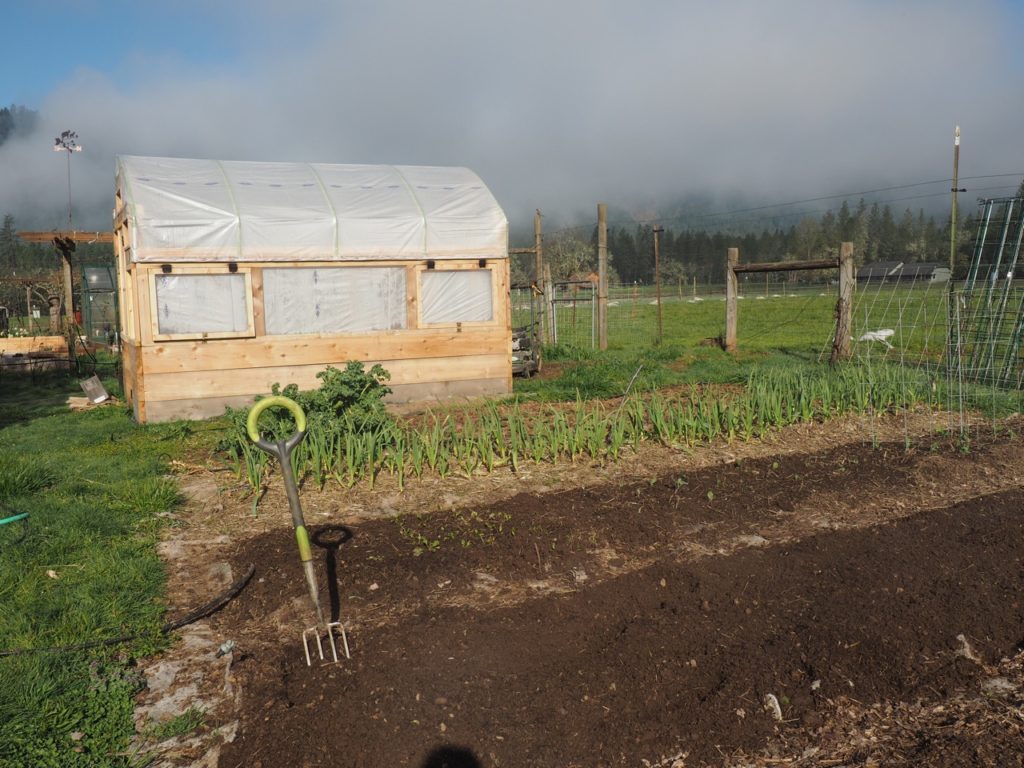
freshly tilled garden beds, ready for planting

raised beds going up one level–buiulding them is no problem–it is filling them that takes time and so much material!!
News from the North
Its been an exciting month as we edge towards spring with days alternating between sunny and warm with bees buzzing, then three inches of snow on the ground and freezing nights. Quite different than the mild east bay! We now have a total of 10 new lambs with (fingers crossed) more on the way (is that sheep pregnant or just fat?). Last week our first calf was also born. So adorbs. I am way behind on my gardening…with bulbs and tubers sitting and waiting to be put in the ground…in most ways still too early here..but the gardener in me is itching. The greenhouse is busting out, daffodils are still abundant and the fruit trees are starting to spring back to life. We are working on crossfencing our pastures to start rotational grazing and experimenting with what seed might germinate to grow forage crops. The raised beds are going up a level, and we are not looking forward to the back breaking work of mucking out sheep shelters to help fill them.
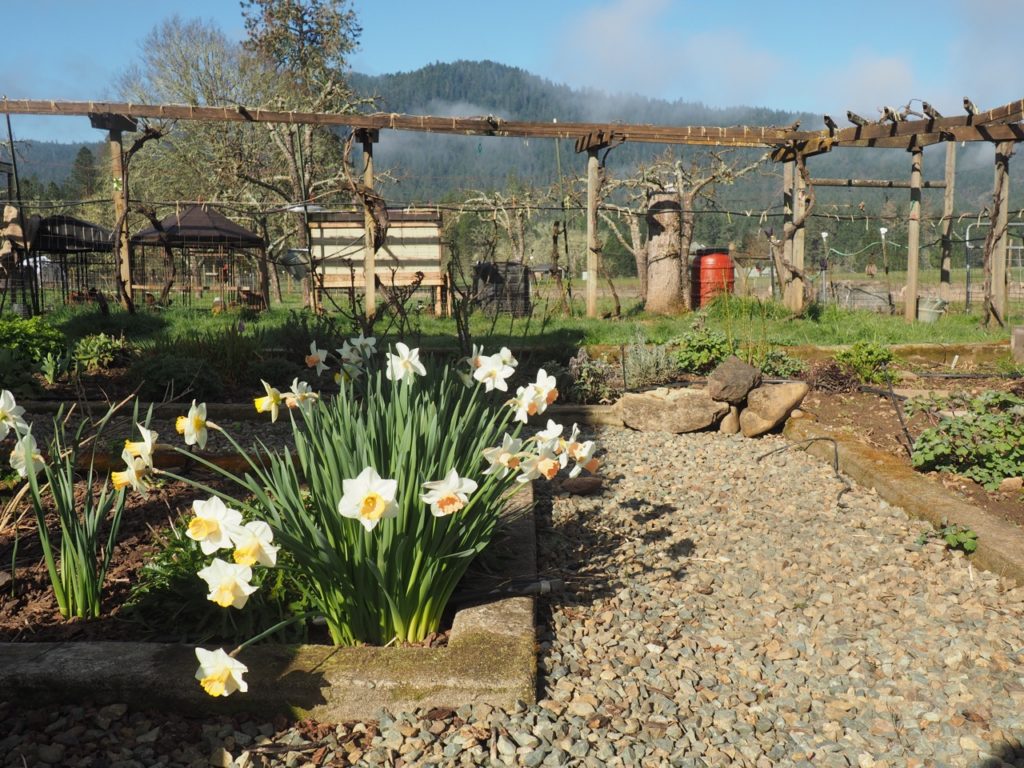
daffodil explosion with neatly pruned grape trellis in the background
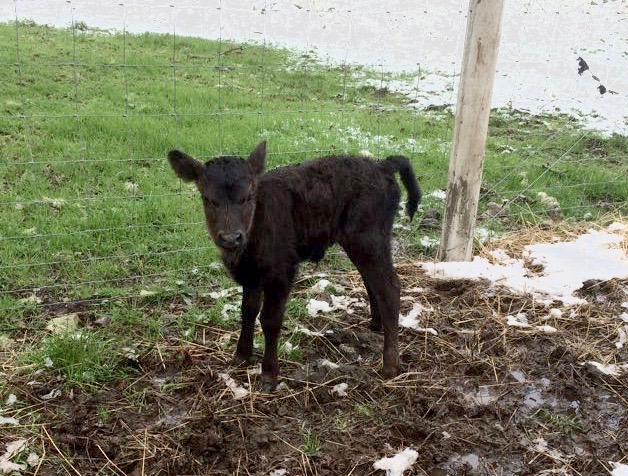
baby cow!!
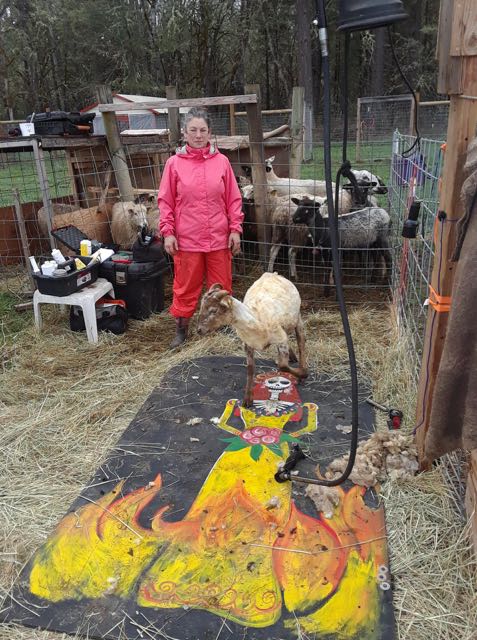
Our Day of the Dead altar has been repurposed several times now on the farm. In this picture we are using it as a shearing board on a somewhat damp morning (thus the raingear).
MARCH
Hello Folks
March snuck up on me and I am just now sitting down to write this monthly missive. We are under a pretty deep blanket of snow and big fluffy wet flakes continue falling down here in Grants Pass, so though Spring is right around the corner it doesn’t fully feel that way. Yet the chickens are laying, lambs and bunnies are being born and the daffodils stand bravely in the snow.
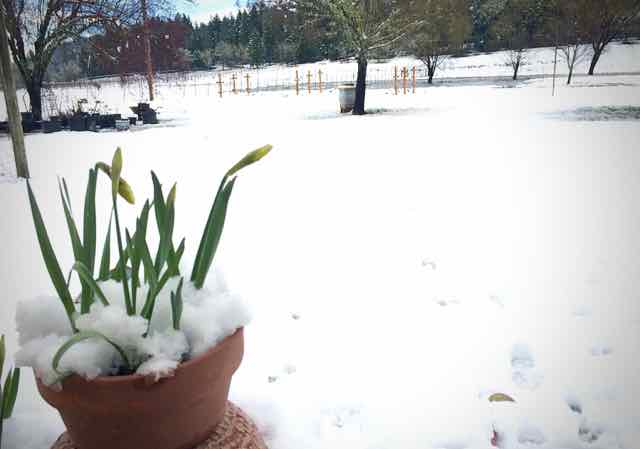
Yelp Raffle Winner
And the winner is…..Tyler B. To claim your prize, just register for any normally priced 3 hour class, leaving the amount blank and writing yelp raffle in the comment box. Thank you to the others who posted for your honest reviews!
Spring in the Garden: Fruit Tree Pruning Basics
Our rose family fruit trees (plum, cherry, peach, apple, pear) can be pruned two times in the year, when they are dormant up until “bud break” and late Summer/Fall after fruit production and before dormancy. The plums and cherries are already starting to bloom so if you haven’t started pruning, this is your last chance until Fall. Dormant pruning should be done on a day when it will be dry for 3-4 days after to allow the wounds to heal and prevent disease from entering the open wounds. The hormones that produce fruit move more slowly on horizontal branches and fruit needs direct sun to sweeten up, so a single layer of horizontal branches with small fruiting spurs coming off these main “scaffolds” is what you should be going for in terms of structure. Fruiting wood is different for different trees. Peaches and figs fruit on first year wood that grew in the last season, so shortening main branches and encourage short stubby new growth is essential. Apples and pears produce on wood 2 years old or older and fruit “spurs” produce for 5-10 years. Plums and cherries are somewhere in between. Backyard fruit trees should be kept low. Choose 3 main scaffolds that spread out from the center and remove others. Reduce in height by cutting above a horizontal branch. Keep the center of the tree clear. After making any large reductions, continue with the 5 Ds. Clear anything Dead, Dying, Diseased, Deformed or Doubled (two branched growing parallel in the same space). Cut suckers (at base of tree) and water sprouts (new growth going straight up). Cut anything crossing the center or growing back towards the center. Cut all other new growth back to 2-3 buds. Cuts should always be made just past an outward facing bud and at a slight angle. Once you have gone through these steps, stand back and look at the tree. Can the sun access all branches? Is there anywhere that looks too dense. Anywhere the tree is too tall?
 Fruit tree restoration. Year 2 of restoring fruit trees never properly pruned. Notice we have reduced trees to 3 main branches and one layer.
Fruit tree restoration. Year 2 of restoring fruit trees never properly pruned. Notice we have reduced trees to 3 main branches and one layer.


Before and after, from the same restoration. We are leaving this one a little taller for shade, notice we still have a bowl shape, but 4 main branches and two layers.

Showing the fruiting spurs on various trees, notice that a leaf bud is smaller and protrudes less. Photo from Country Trading Co.
News From the North
The last month has been odd…it felt like Spring with temps up to 70 and color starting to show on fruit tree buds. The daffodils started blooming, chickens started laying and two of our ewes have pushed their lambs into the world. Then 2nd week of February we got hard freezes, several inches of snow and rain rain rain. The previously mild weather was a boon for getting some things done…In Early February we pruned our entire orchard and installed 40+ new fruit trees, filling in the existing orchard and establishing a cider plot. The berry trellises are up and braced and we have started to build the soil underneath with the urine and manure soaked straw from our sheep shelter. After countless issues with rabbit fertility (they don’t always breed like rabbits), I learned that the rabbits, like chickens are photo-sensitive—breeding relates to day length—so I installed lights on a timer in the rabbit barn and put heating pads under nest boxes and finally have had a few successful litters.

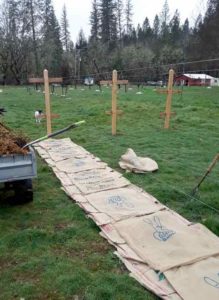
 MARCH & APRIL CLASSES
MARCH & APRIL CLASSES
Sadly our early March weekend of class has been cancelled due to low registration. Please register early to prevent this from happening!
Our next classes and bulk of our spring programming will start later this month. Please join us for Backyard Chickens, Natural Beekeeping and Gardening 101!
Creative re-use: Mucking out the sheep pen to build berry beds. First we lay down a layer of burlap sacks as mulch and layer up the sheep bedding. We’ll add a little compost and plant the berries directly into the built up layers.
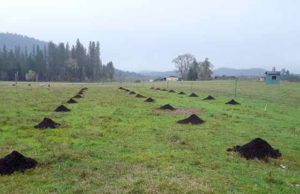

Cider apple plot. These are fenced with semi-permanent electric fencing. Irrigation will be raised off the ground on wire. 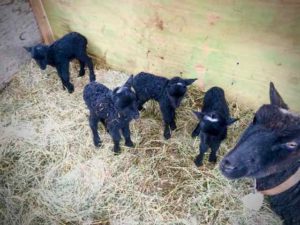
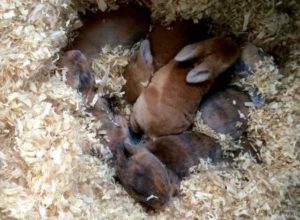
FEBRUARY
Hi Everyone
Seems like time is flying like the wind in 2018. It promises to be a busy full year for all of us, but I hope you still have some time to take some of the delicious classes we have prepared for you this Spring. The classes are up online. The mild winter means spring is here early for the entire West Coast so it is already time to start our spring gardening. See our monthly gardening tips below.

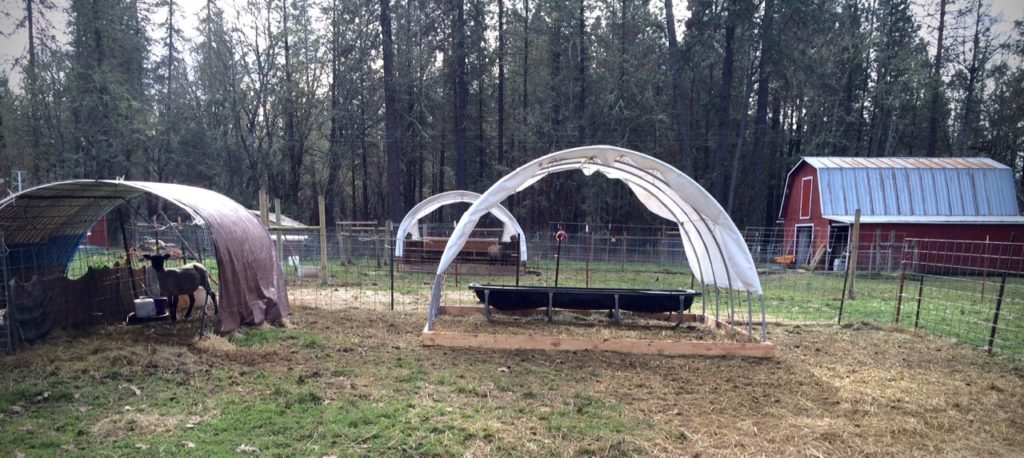 Top: Sheep feeding on the winter field
Top: Sheep feeding on the winter field
Bottom: A shanty town of sheep shelters. The one on the right cost only $100 and took an hour to assemble
Win a Free Class! ~ Yelp Raffle Review
We want to know how we are doing? Write a review about your experience in our classes or on our tours between now and March 1 and be entered in our raffle to win a free class! Go to the following link and write your honest review. Everyone who reviews between now and March 1 will be entered in a drawing to win a free class. The odds to win are usually really high and either way you help us out greatly! https://www.yelp.com/biz/the-institute-of-urban-homesteading-oakland
February in the Garden
It is already Spring in the East Bay and time to get seeds going in flats and cool weather starts in the ground. Seeds can be started indoors or outdoors in February and will get a little boost if you give them a seedling heat matt and dome. For indoor seed starting, a light will also be necessary. It should be height adjustable and should start out close to the soil—3-4” above it and move up as the seedlings sprout. The heat matt should stay on 24 hours a day, but the light can be set to be on 12-14 hours. You can sprout your seeds in a flat or 6 packs, or directly into 4” pots. Keep them evenly watered and make sure they have at least 2 sets of leaves before transplanting them to their permanent home in the garden.
Spring is unfortunately also often a time for slugs and snails, waiting to gobble up your tender new seedlings. If you are installing new raised beds, it is always a great idea to staple copper mesh around the edges as the slimies don’t like to cross it. In the garden the best prevention is to handpick slugs and snails off plants at night. A concerted effort every other night for 2 weeks can knock the population down and interrupt spring breeding. Lastly, crumbled egg shells around the plants can also be an effective deterrent.
Finally it is also time to start weeding out all the oxalis, cress, pigweed, filaree and other weeds that have sprung up from the winter rains. Get them now before they flower and seed! Weeding gets a bad name as far as work in the garden goes, but put on your headphones, listen to some tunes and get it done. There is nothing like the feeling and look of a well weeded garden.
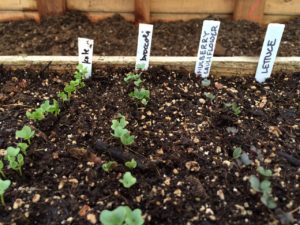
 February Gardening: Seed your flats and weed, weed, weed!
February Gardening: Seed your flats and weed, weed, weed!
News From the North
In early January, eighteen more sheep arrived, raising our count to 32, and we are expecting our first lambs any minute now. The mild winter has allowed for lots of projects to be set in motion. We completed our first big fencing project, fencing off about a half acre to create out “home pasture” which consists of 6 smaller fields, connected by gates, so that we can sort sheep into breeding groups, or quarantine sick animals. Right now we have the pregnant ones separated so we can feed them better and hopefully have them lamb in a dry shelter. The project required setting 28 wooden posts, 35 T posts and hanging 6 gates. I think I can finally say I am a real homesteader ( : Next we are working on a small but sturdy cow corrall, so we can catch and pen our two Dexters, who may calve anyday now. We are also getting more fruit into the ground. We filled in our existing orchard, interplanting between existing trees and are working on fencing off an area of pasture for the cider orchard (mostly traditonal english cider varieties and a few perry pears). Also in the works is 120 row feet of berries, so I have been in the shop preparing my berry trellis posts out of utility grade cedar. Then…on to fruit tree pruning…. So much to do!
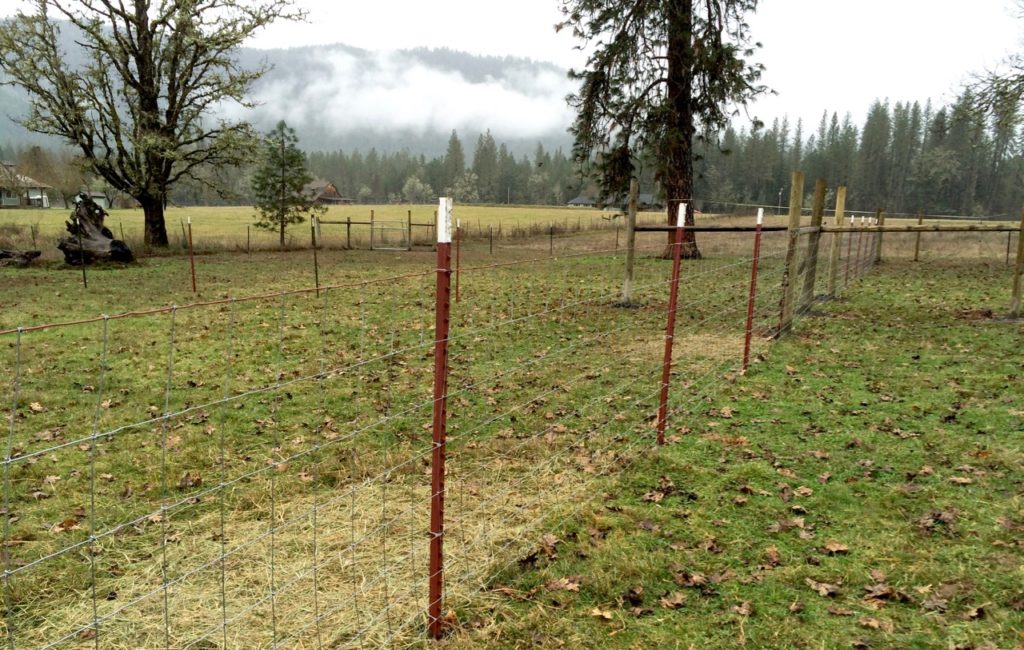
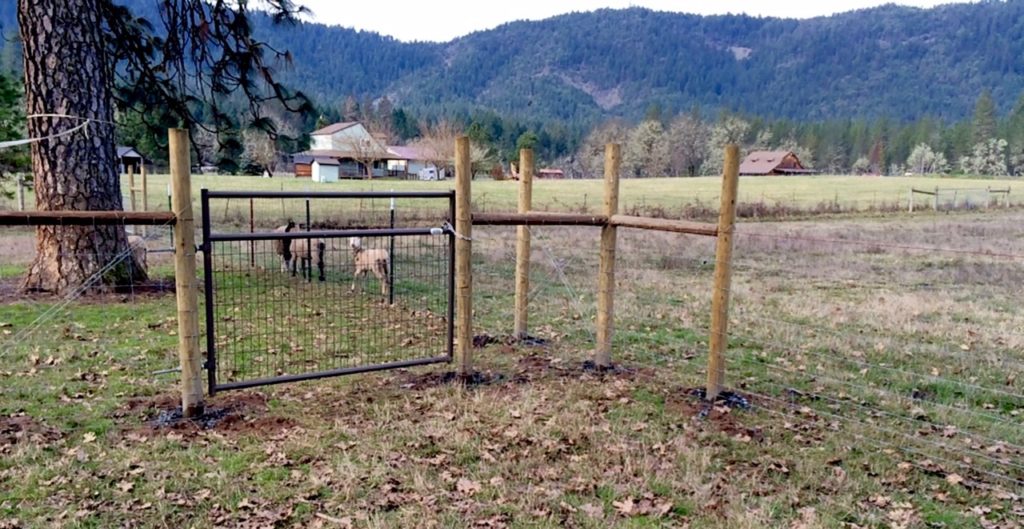 Learning Curve: Fencing. Lots of hard woork digging holes, setting posts and getting the fencing stretched tight.
Learning Curve: Fencing. Lots of hard woork digging holes, setting posts and getting the fencing stretched tight.
Seeking Teaching Sites
Continuing to teach nomad style in the Bay Area and seeking sites for the following classes. Hosts and their housemates can attend free. If you are interested, please tell me where you are located and send a description and photos of the site/space you have available. Thank you!!
Saturday March 3 10am-5pm Two classes: Dormant Season Fruit Grafting and Backyard Orchard: Fruit Tree Pruning This would best be at a garden that has a number of fruit trees we can look at and prune.
Sunday April 2 10am-3pm The Real Dirt: Intro to Organic Gardening This would be best at a garden that is already in progress, with some composting systems in place
Tuesday April 4 6:30-9:30pm Cheesemaking 101: Ricotta, Feta and Mozzarella
Sunday May 20 10am-12pm Pollinator Paradise: An Introduction to Pollination Ecology this would be great in a garden that has lots of flowers
Sunday May 20 2pm-6pm Canning Extravaganza: Jam, Pickles and Tomatoes
Spring Season 2018 March 3-June 9
The Spring schedule is up and classes are open for registration! Please keep your eyes out for a few late breaking additions, which we hope to add later this month. Find the Spring Calendar here.

Puppy life on the farm: Our youngest members snuggle under the hay feeder on a cold afternoon.
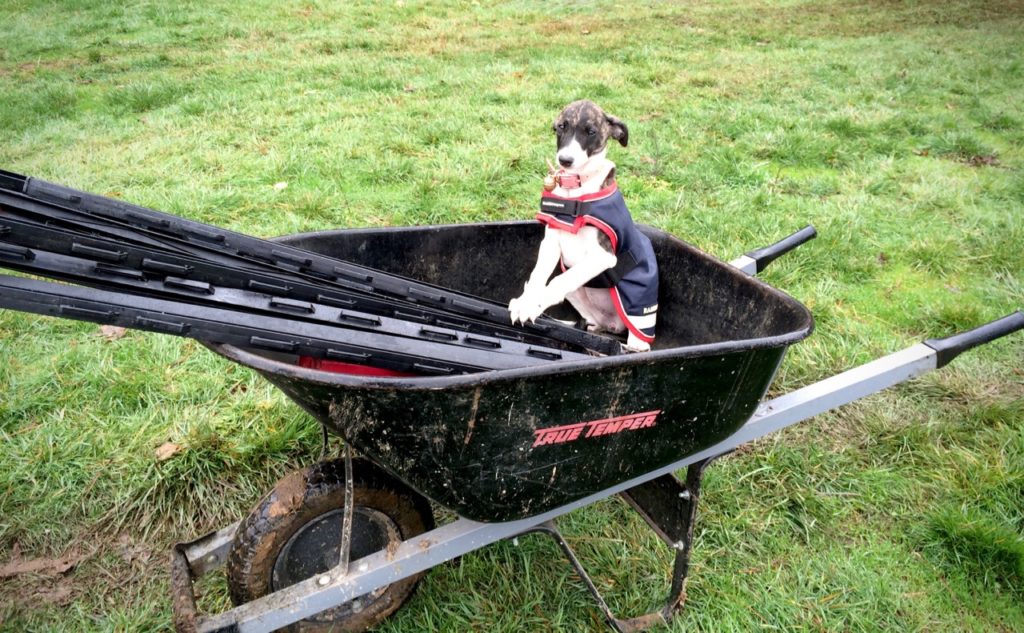
Puppy life on the farm: Piper gets a ride

JANUARY
Hello Homesteaders and All
Happy New Year! We hope the new year brings health and happiness, including opportunities for growing and gardening and learning new things!

 New Residents: Munchkin Maia on the left and Goose & Gander on the right.
New Residents: Munchkin Maia on the left and Goose & Gander on the right.
CLASSES
Winter Cheesemaking Intensive
Saturday, January 27 noon-5pm and Sunday, January 28, 10am-1pm 2016
Cost: $175-225 sliding scale includes supplies
If you have been thinking about taking this course now is the time!! Our signature two-day cheesemaking primer includes a dozen dairy transformation projects, information on cheesemaking theory and equipment and a fun party atmosphere as we create a scrumptious feast each day from our cheesy creations.
More info
Bare Root: Selection & Planting of Your Urban Orchard
Sunday January 28, 2:30-5pm
Cost: $40-80 sliding scale
Enjoy fresh sun ripened fruit from your own backyard 10 months out of the year! This course will lead you through selection, planting & general care of fruit trees and berries. We’ll talk about best varieties for the Bay Area, site selection, planting techniques and tips for maximizing fruit production in small spaces.
More Info
Spontaneous Fermentation
Thank you to everyone who came out to our 2017 Winter Open House—it was a really grand event this year, thanks to our lovely hosts at the Hillegass House. If you bought a bottle of Plum wine from me, I expect it has popped it s cork by now. Sorry! I had stopped fermentation and added a bit more sweetener and I guess the yeast critters were not fully inactive. Wine is still drinkable—just put the cork back in and refrigerate. Remind me next year and I will give you a discount on another bottle.
Spring 2018
We hope to have the 2018 Spring Calendar online by early February, with Classes starting around the beginning of March and running through the end of June. Remember if you want to propose a class to do so ASAP by January 15 at the very latest.
Seeking Faculty
IUH has two faculty positions open for 2018.
Position #1 Urban Livestock Specialist.
Requirements: Have their own urban farm central to Berkeley/Oakland suitable for holding classes of up to 15 people. Experience with a variety of livestock including goats, chickens, rabbits, quail and ducks. Some teaching experience. Good People skills. Good admin skills: responsive to emails within 24 hours, good at keeping records and papers.
Position #2 Urban Sustainability Specialist: Have their own sustainable household or have access to a sustainable household with features such as greywater, rainwater catchment, solar energy, creative re-use, natural building etc. Some teaching experience. Good People skills. Good admin skills: responsive to emails within 24 hours, good at keeping records and papers.
Both positions would require you to develop and teach your own curriculum. 2-5 classes per season. Also required 3-5 hours a month of admin support, mostly promotion & outreach.
Pay is 65% of tuition from your classes—usually comes out to $75-100 per class hour, sometimes a little less sometimes a little more.
News From the North
December was a time of building and design…looking for spots to expand our orchard, put up berry trellises and expand our sheep operation. After finishing our easy up sheep shelter in November we worked on a more complex greenhouse design, 8 x 12 constructed of rough cut cedar, PVC and greenhouse plastic. It has raised beds on 3 sides and the option to put in a shelf for seed flats. As well 4 windows, two for venting, one for a fan and on automatic openers. We have dubbed her “Growing Pains Palace.” In December we also butchered our bull and the 3 2017 boy lambs. It feels good to have the freezers stocked, including lots of scraps and bones for our dogs. Next up will be developing our animal handling facilities as the arrival of 20 more sheep from California is imminent. In addition we have been enjoying a relatively dry winter thus far and cosy fires in the fireplace.
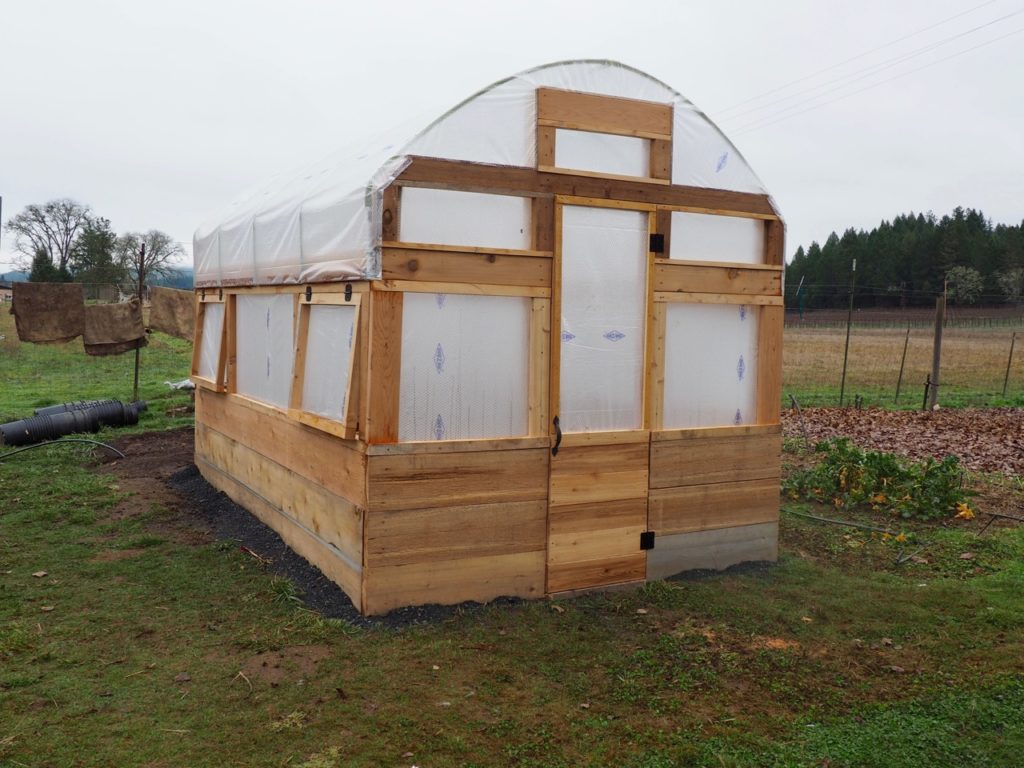
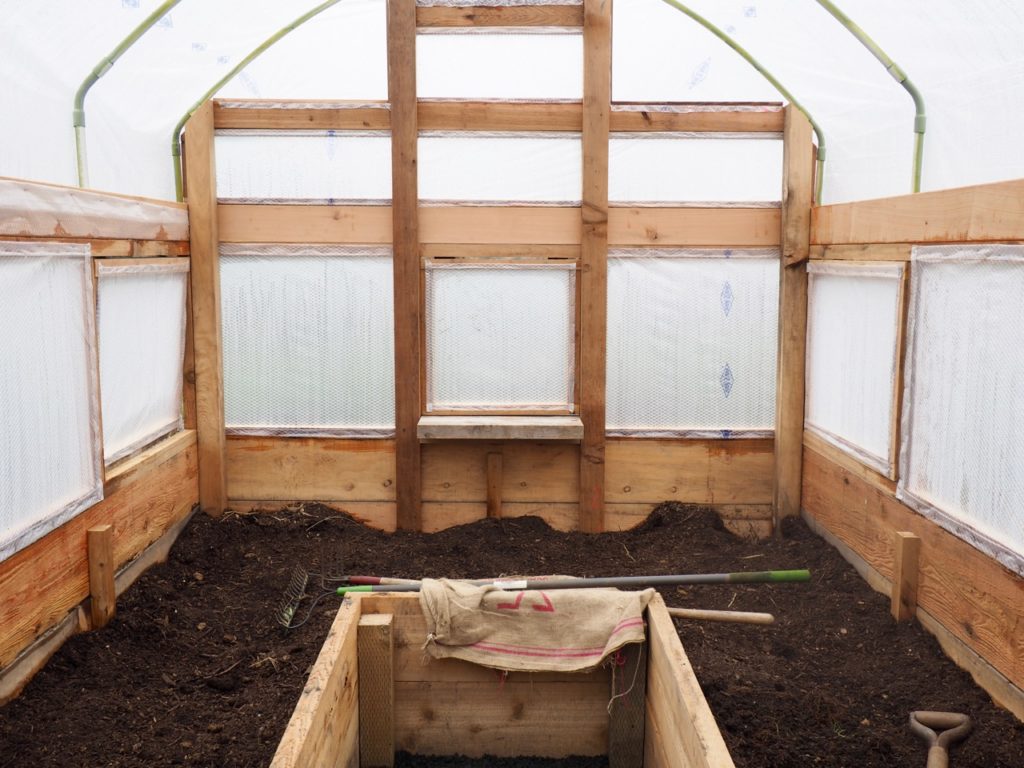
Just completed except for some small finishing touches, a mini greenhouse with raised beds inside to extend the gardening season and help with seed starting
January in the Garden
It’s getting to be pruning time. Fruit trees should wait until just before budding out for best disease resistance, but roses and other perennials can be pruned in January on any day when it will not rain for the next 3 days. This gives times for the cuts to dry out and start to heal over. Prune roses down to about 3 feet in a bowl shape, leaving 4-6 of the strongest upright, outward growing canes. Make your cuts at a slight angle just above an outward facing bud. Keep a few of the stronger canes you have cut to propagate new roses. Here’s how. Cut sturdy lengths of 2017 growth with at least 5 nodes. A node is a spot in the stem where a leaf or stem might grow. There is usually a ring around the stem with a small protrusion—pre-curser to a leaf or new stem. These are also the sites that will spring roots if they sit under the soil. clip off stems and leaves so all you have is a stick. Plant the sticks with the lower 3 nodes covered in a loamy potting soil and press the soil firmly around the propagation sticks. Water thoroughly. These can sit in the shade and should never be allowed to dry out, Sometimes it can take many months for them to propagate—we usually leave ours for a year.

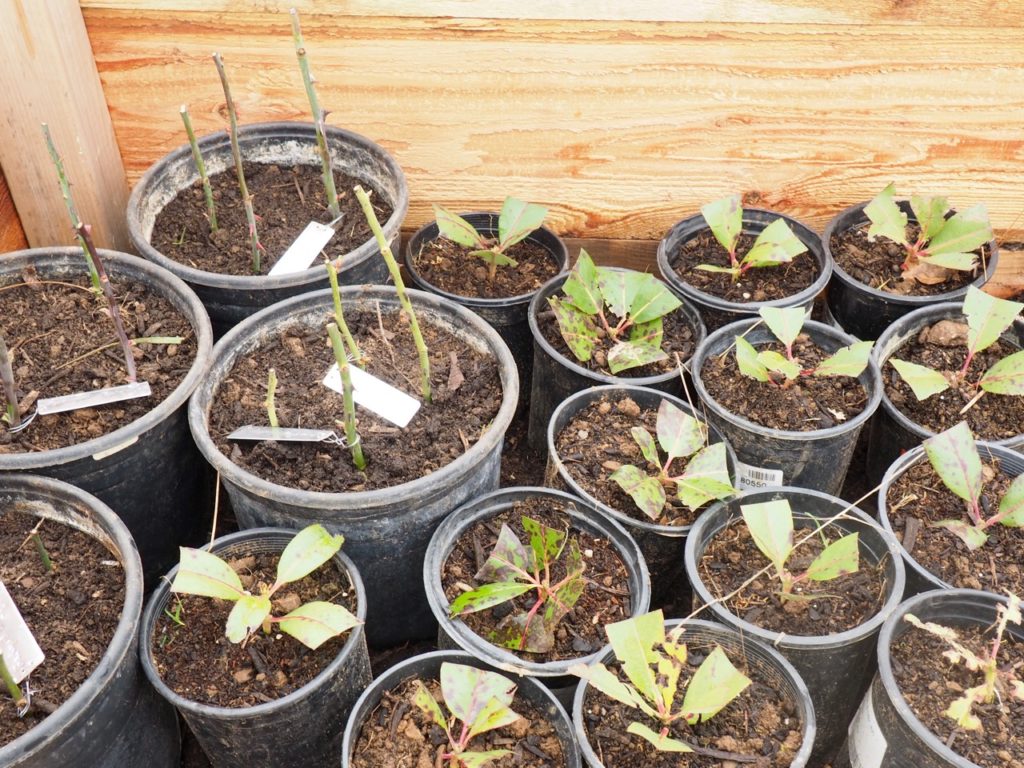
Roses after pruning and rose and madrone propagations for 2018.
Update on Pasture Raised Lamb & Beef
Thanks to those who responded last month. We sold out of lamb instantly to local friends, but expect to have many more whole lambs for purchase next Autumn. We do have a limited number of 10 pound shares of beef available for $100 each. The beef is delicious and tender from our Mini-Jersey bull. You get 6 pounds of lean ground beef and 4 pounds of steak. Pay now to reserve, pick up in North Oakland, end of January. Please respond soon if interested to receive payment instructions. It won’t last.
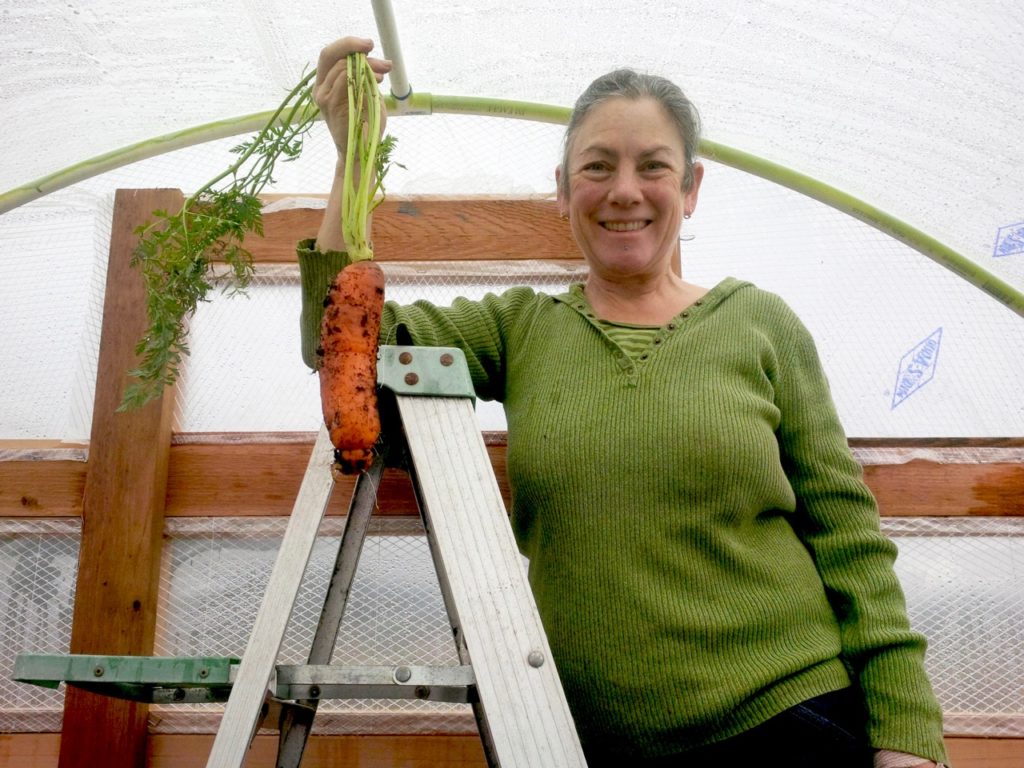
Still harvesting carrots in January!
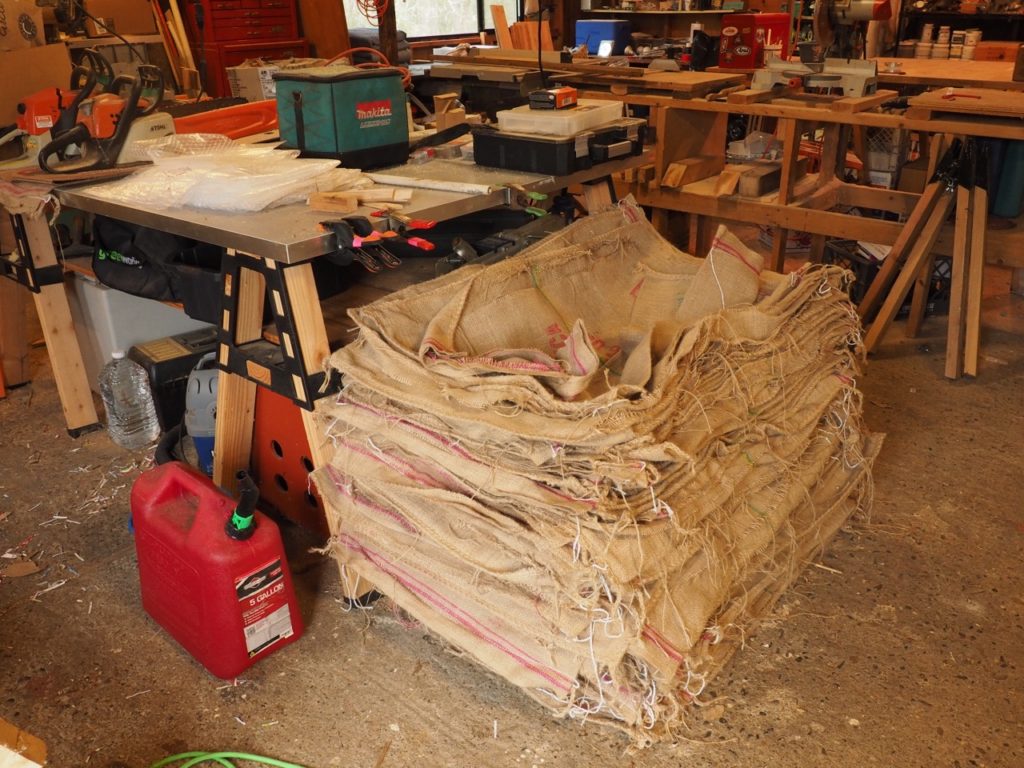
Local resource, as many burlap bags as you want from a local roastery. Mulch, mulch, mulch!
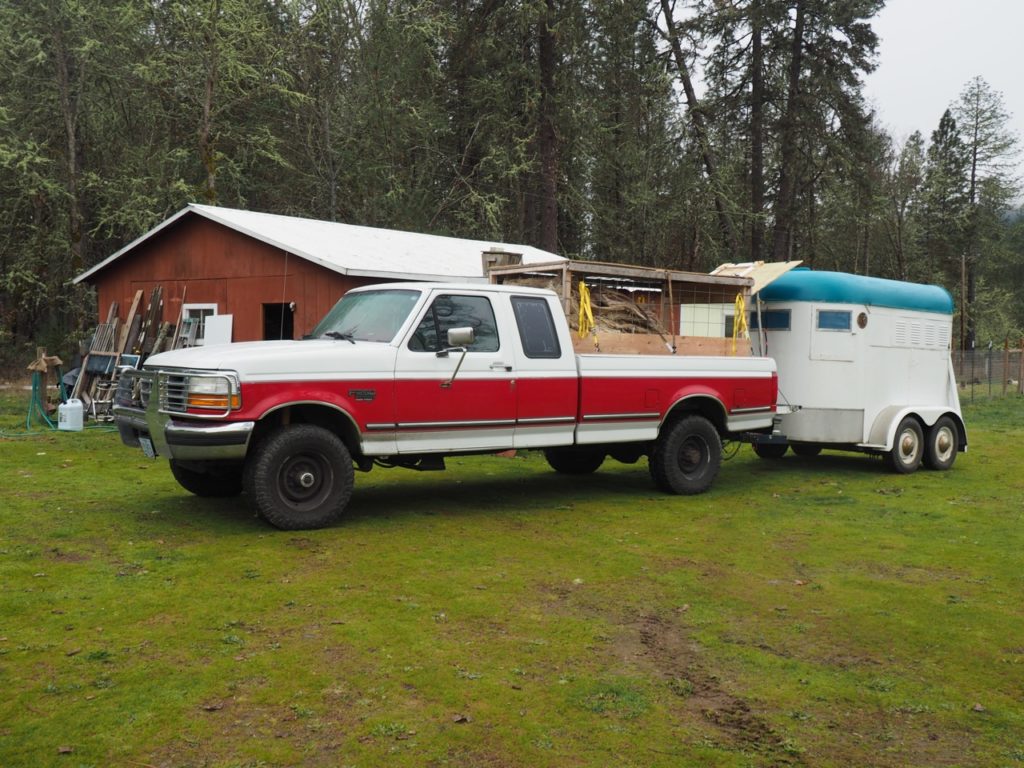
Ready to roll to sonoma county for the first shearing job of the year and sheep pick up.